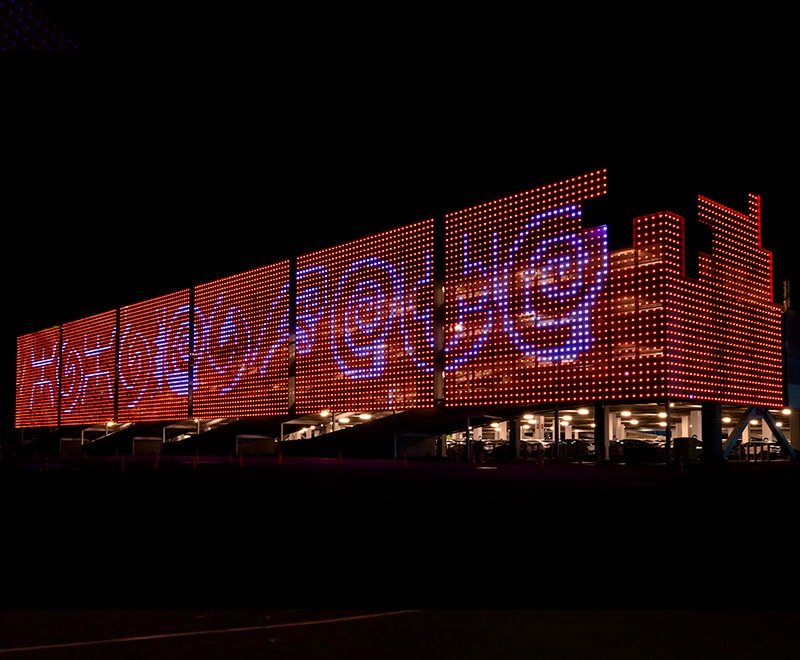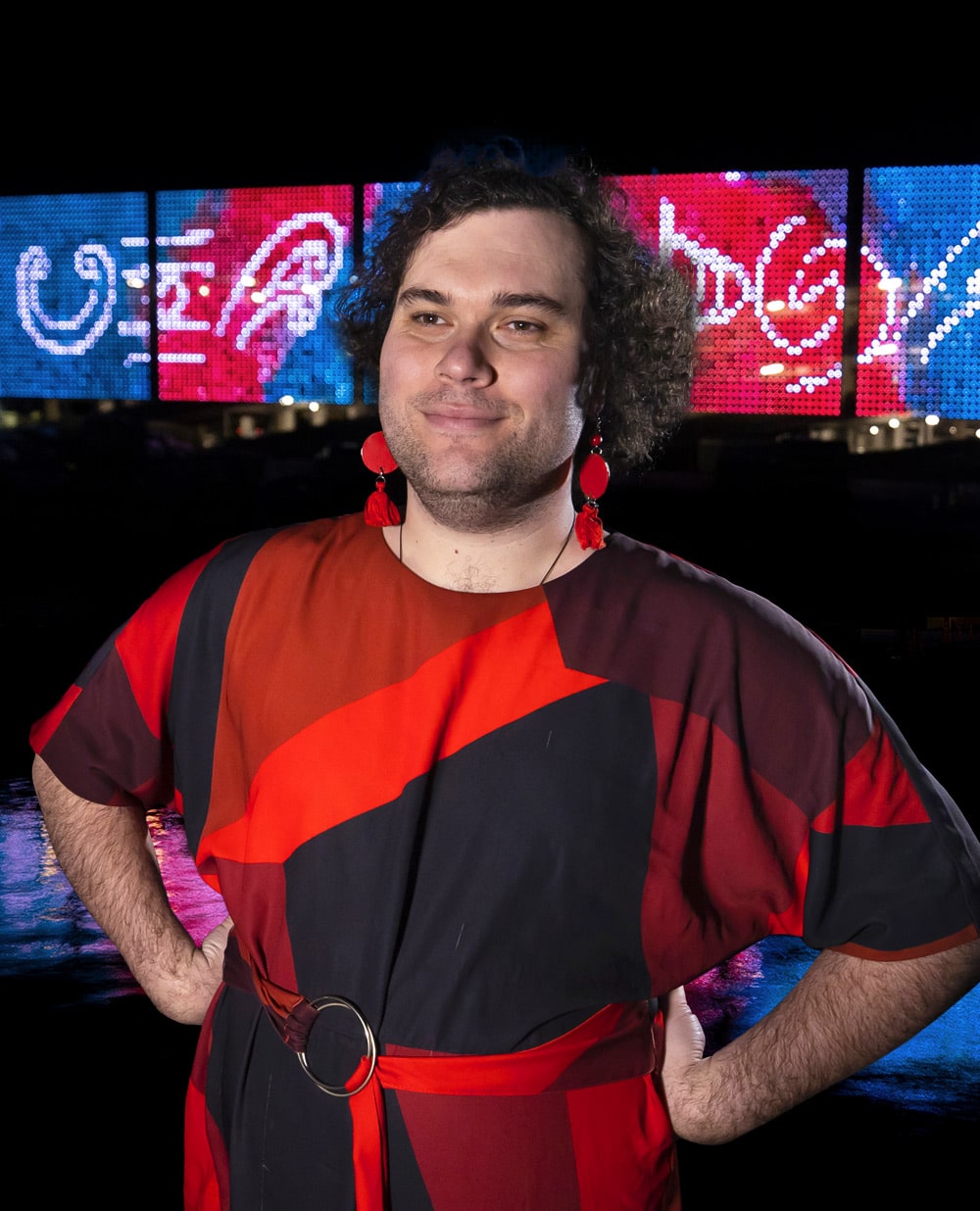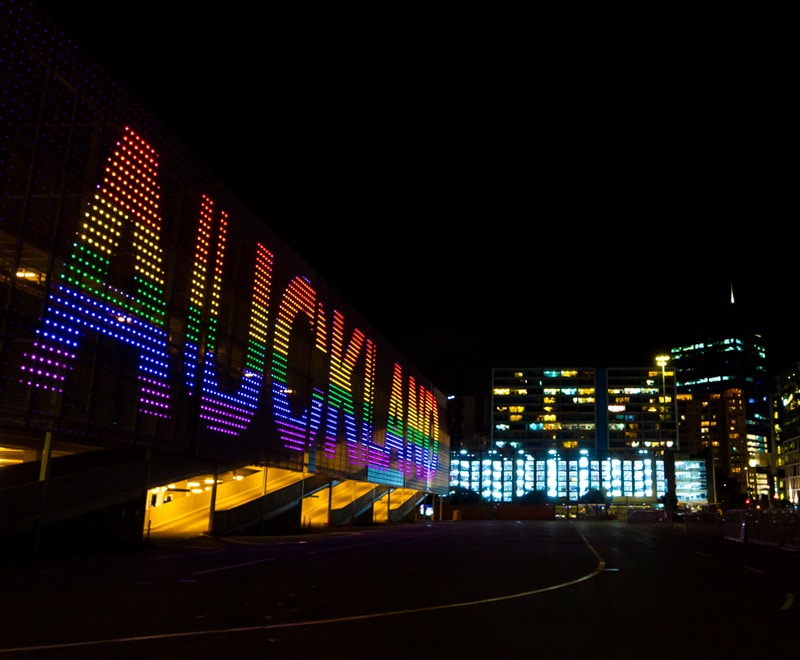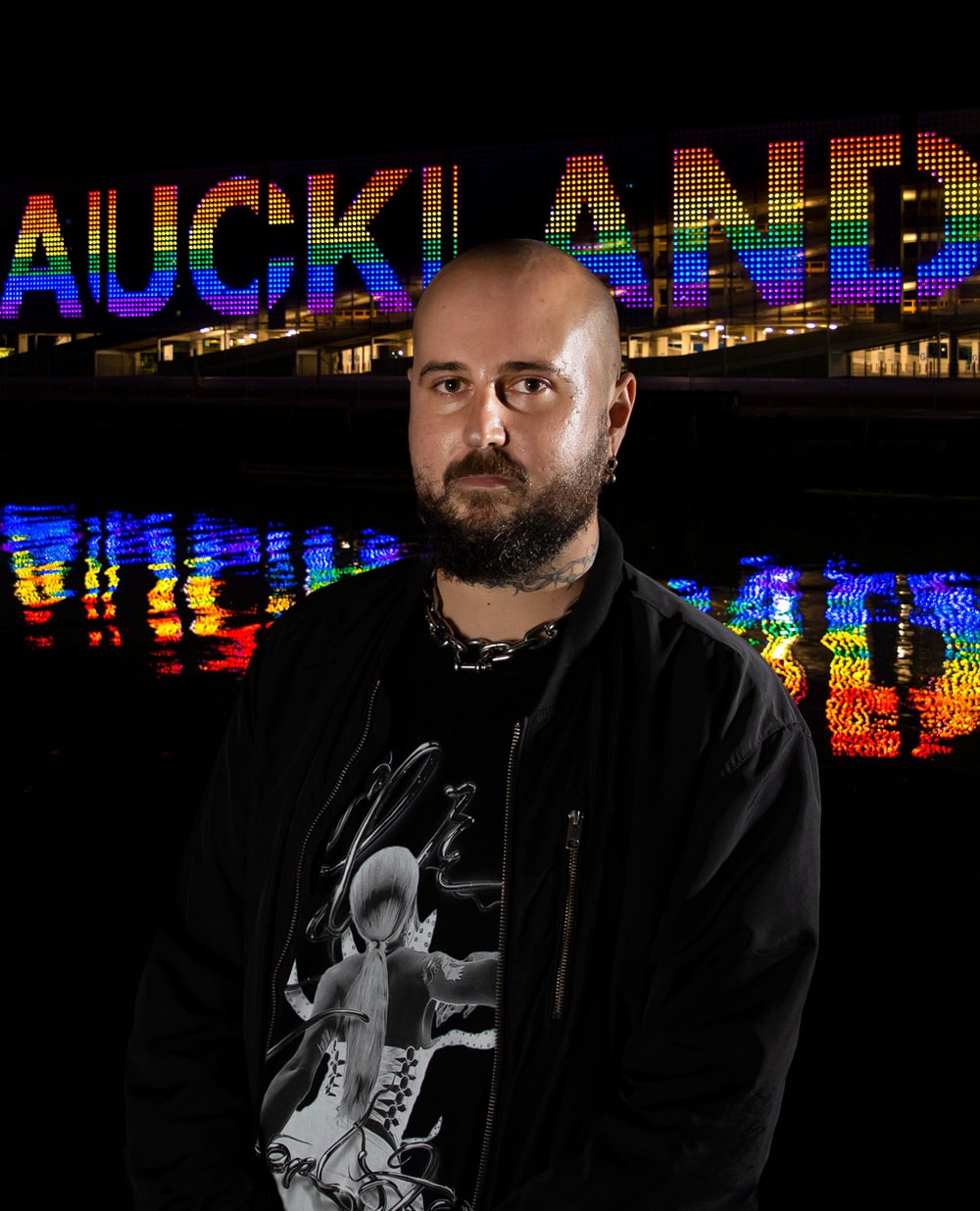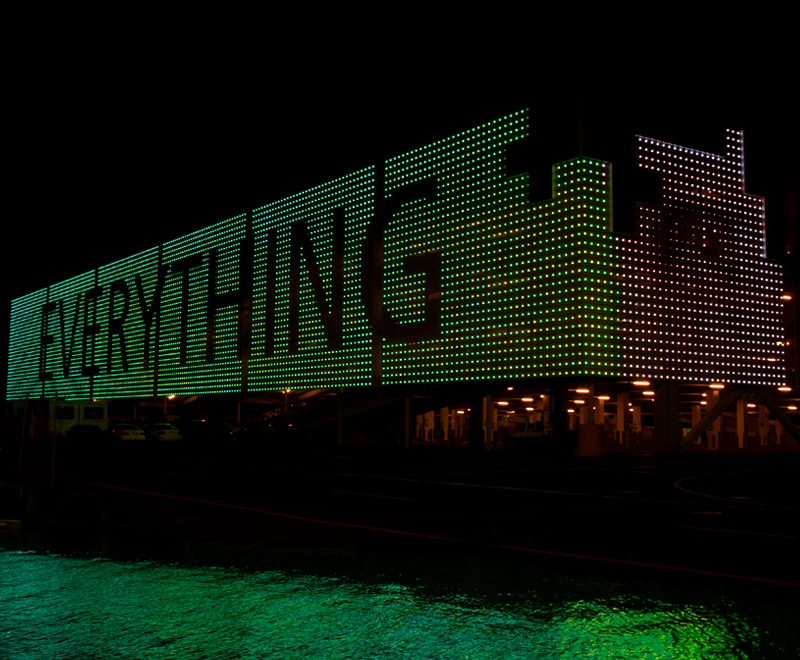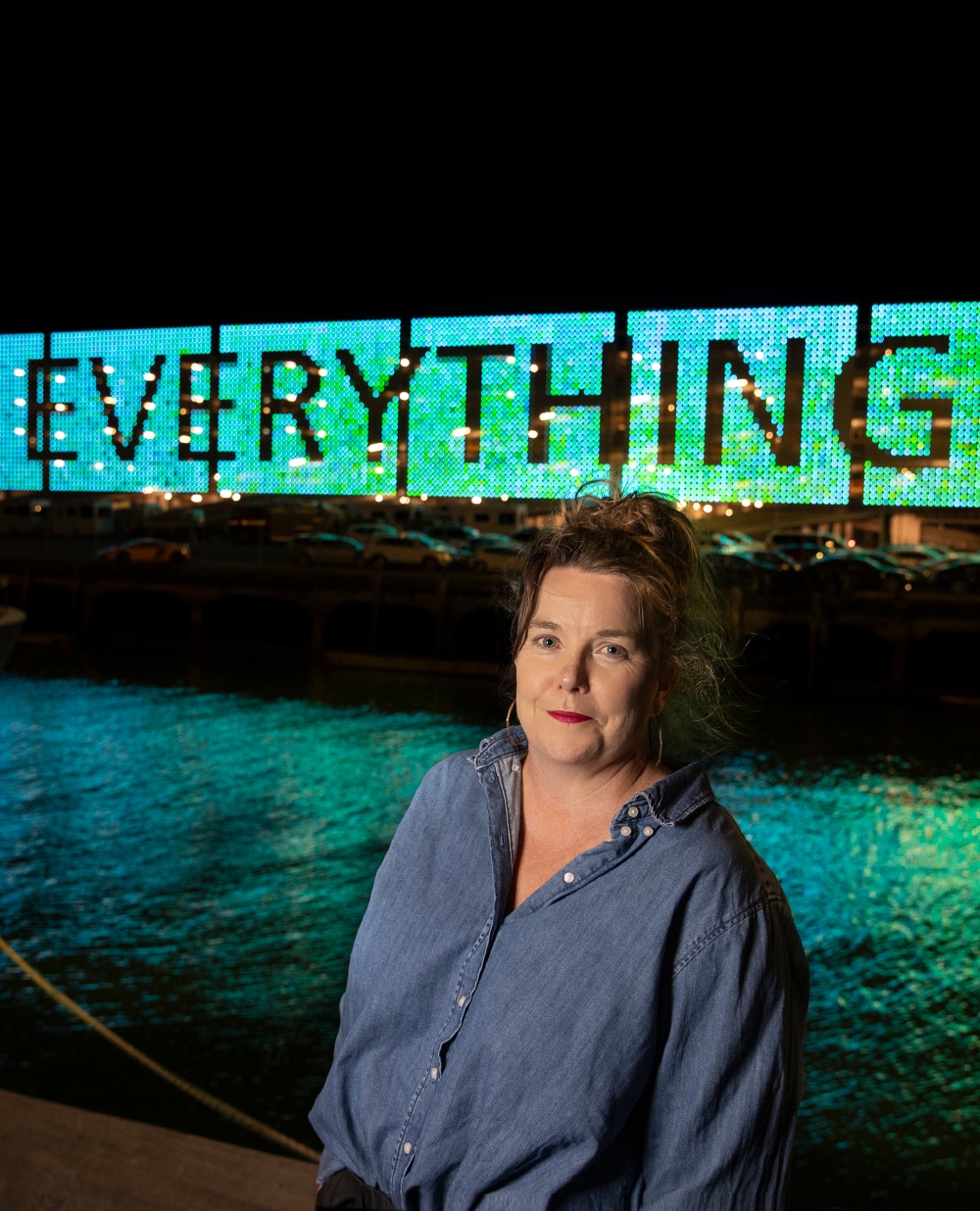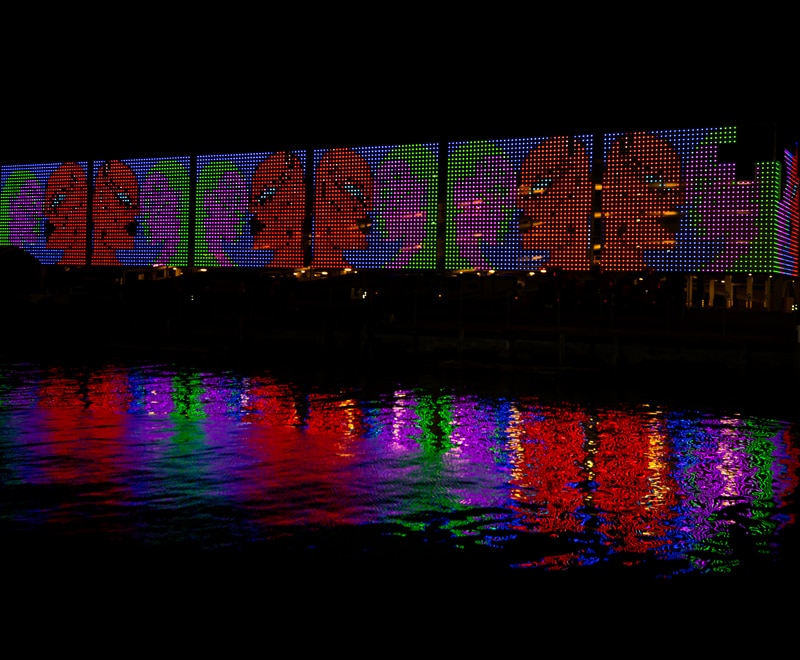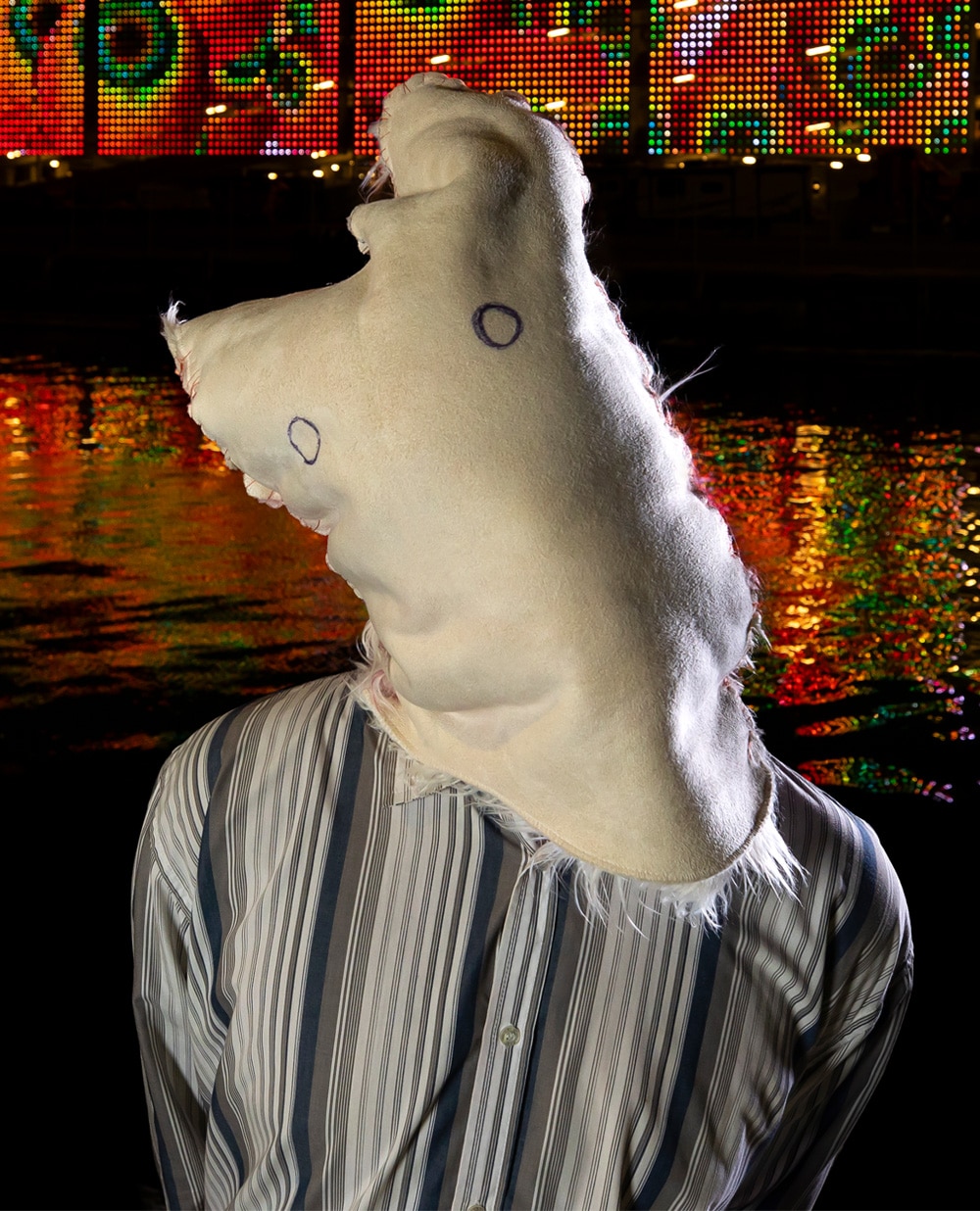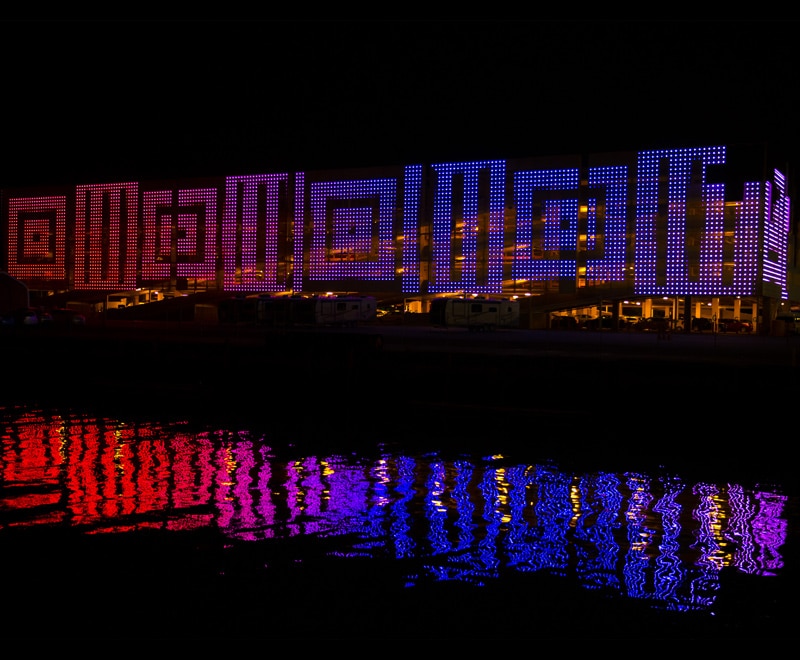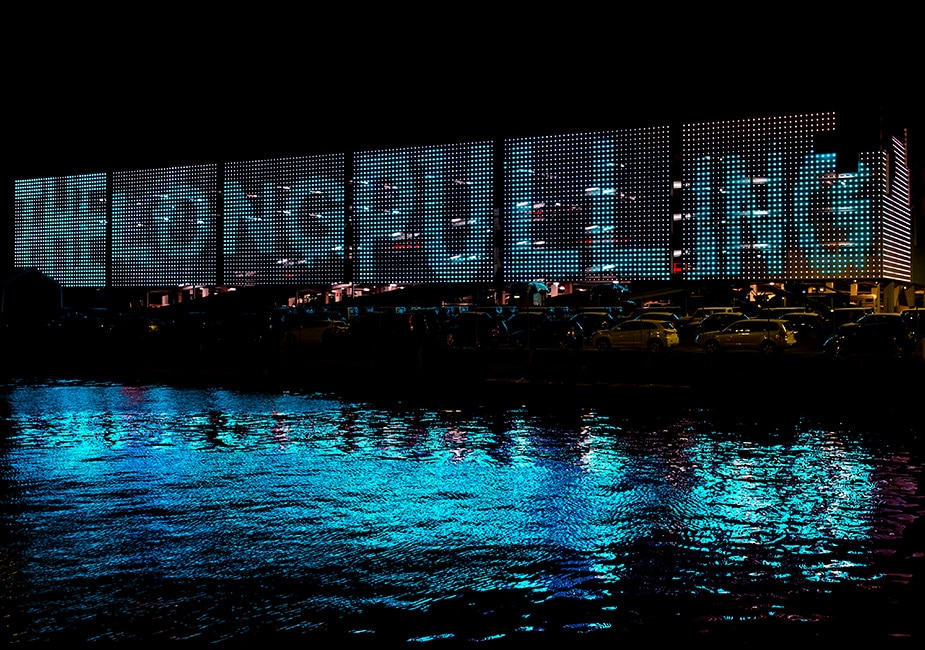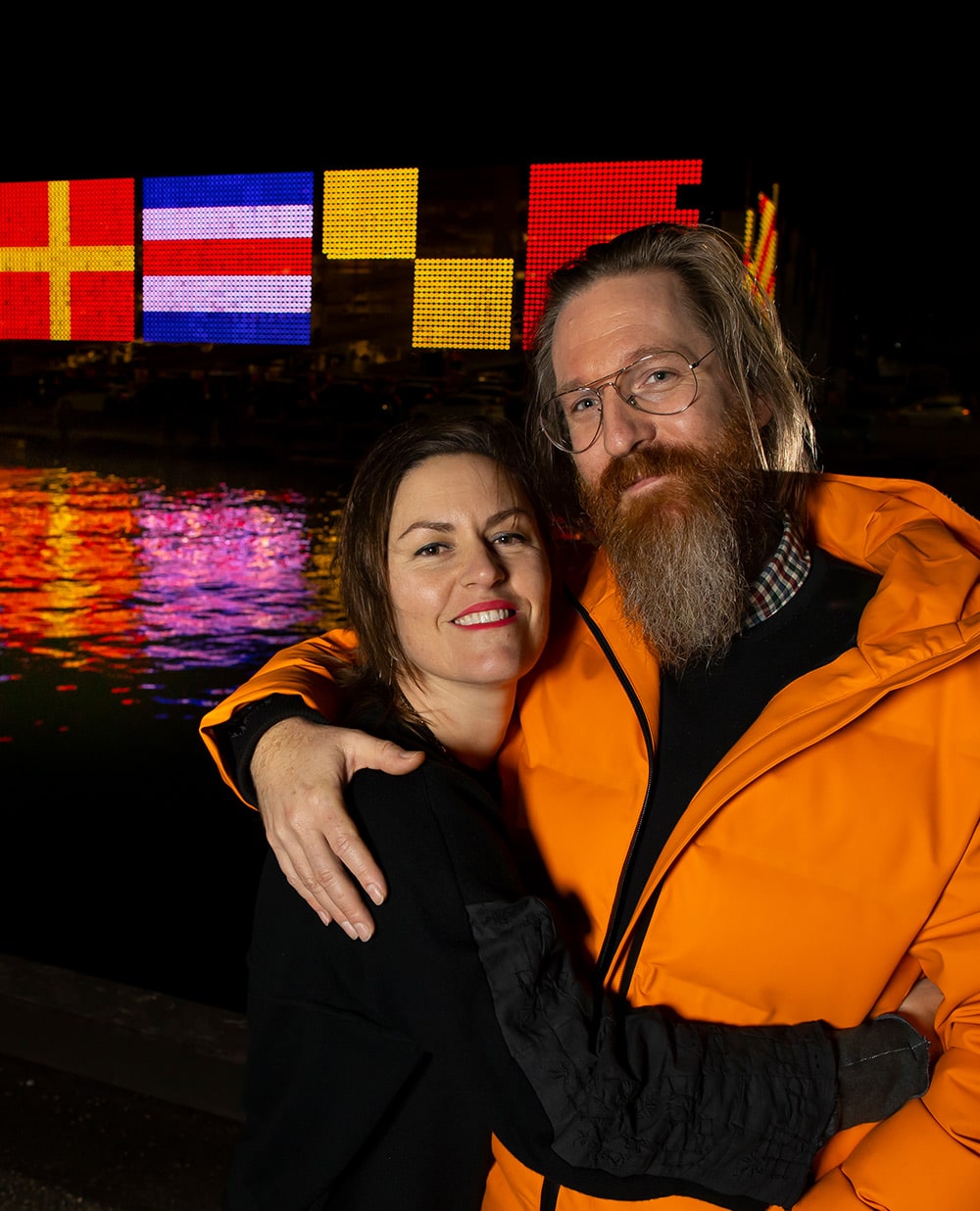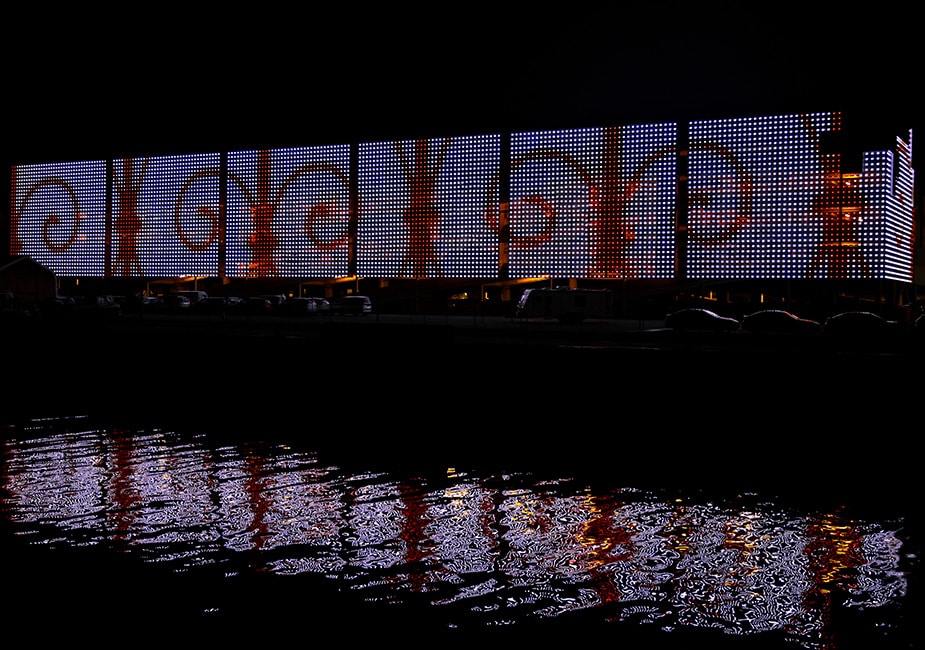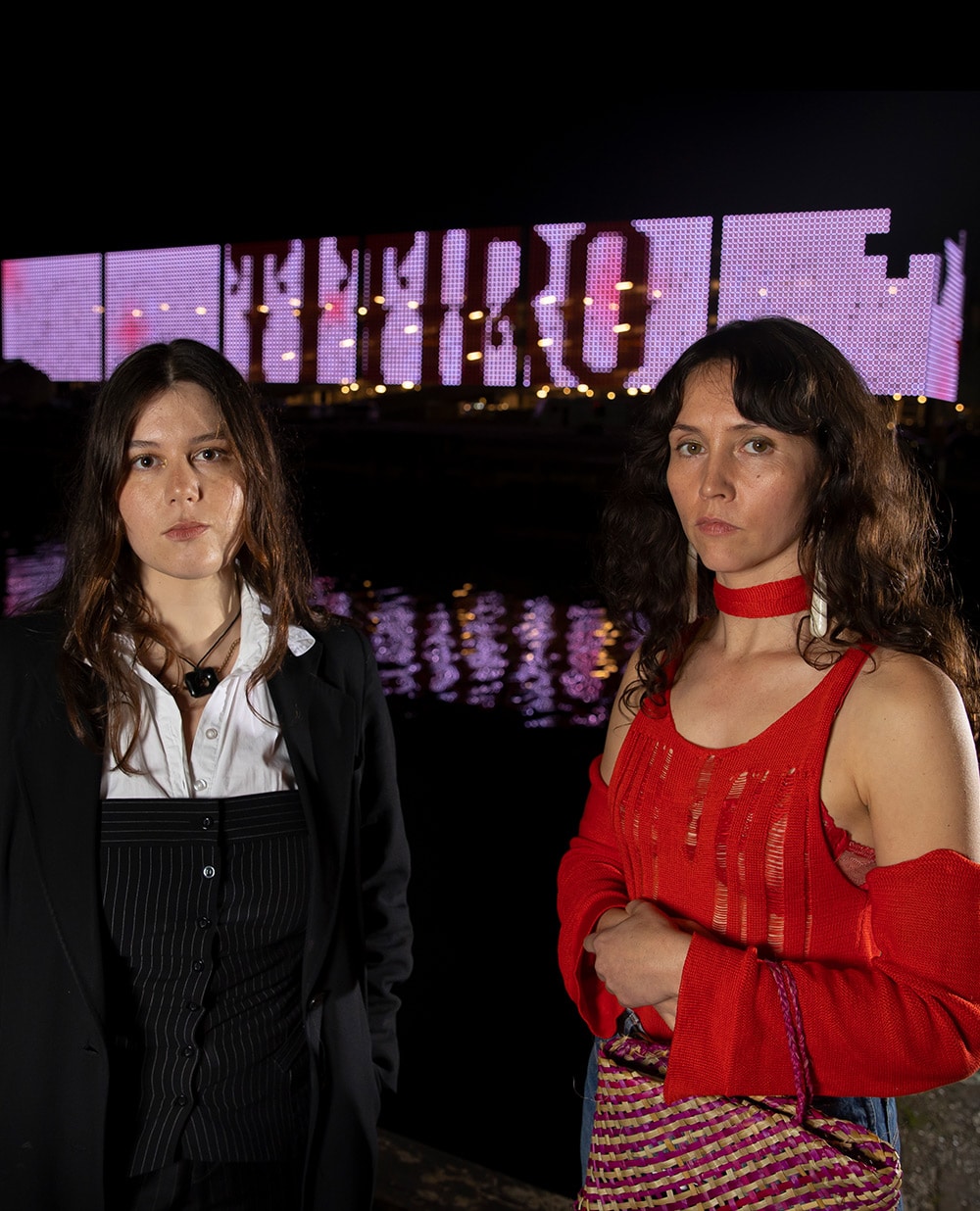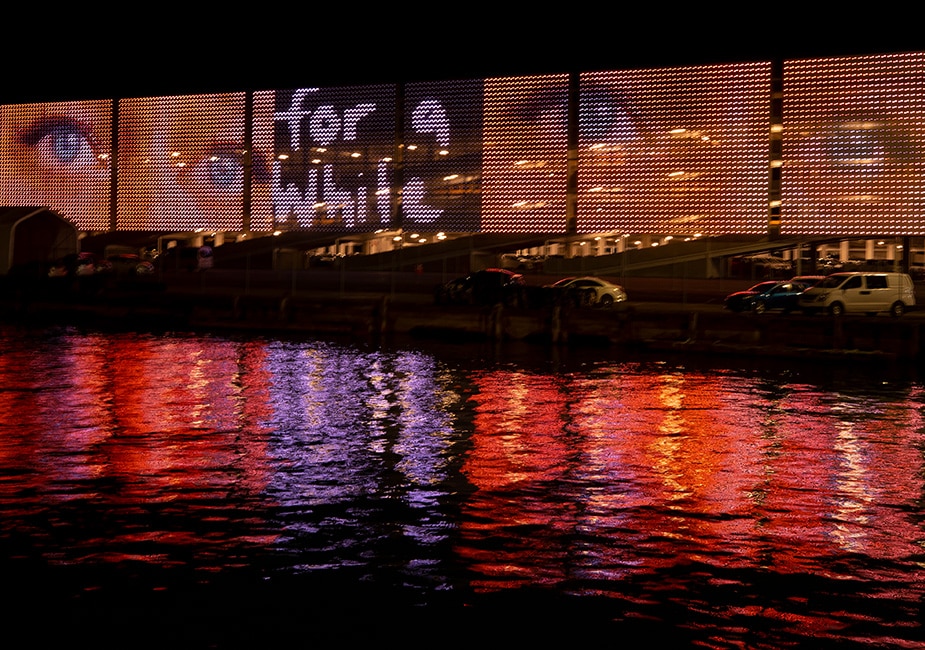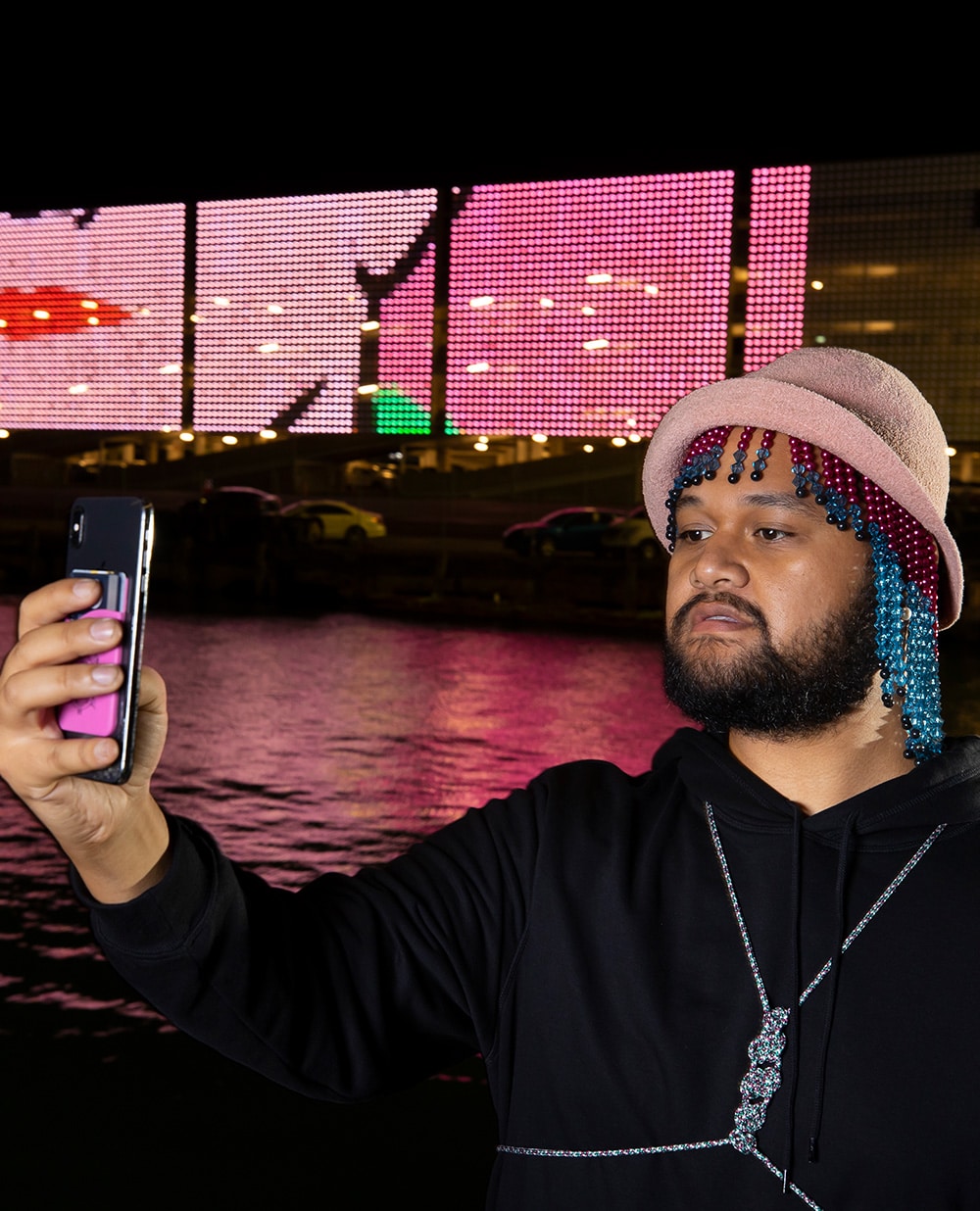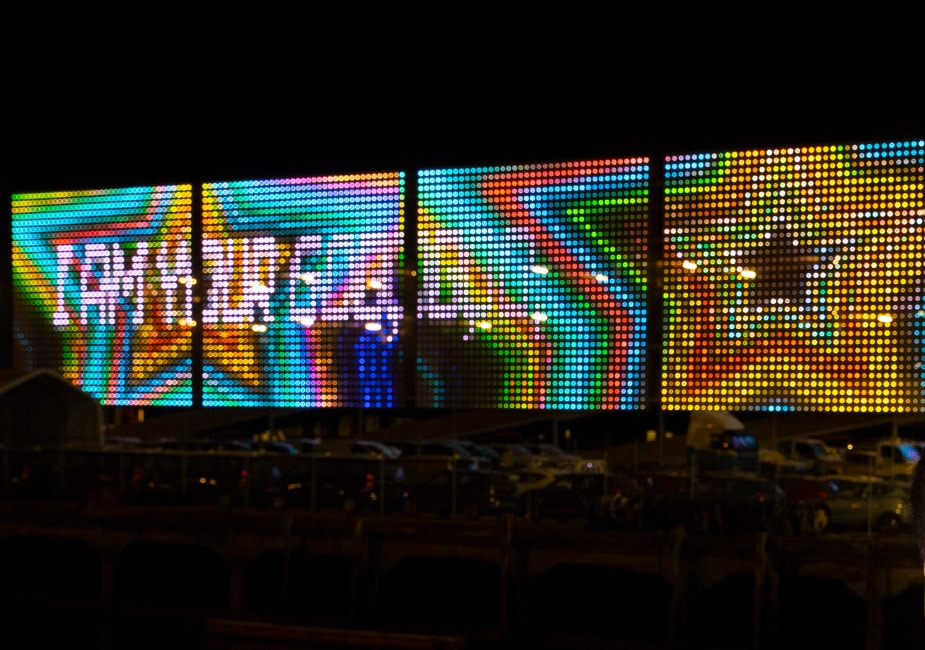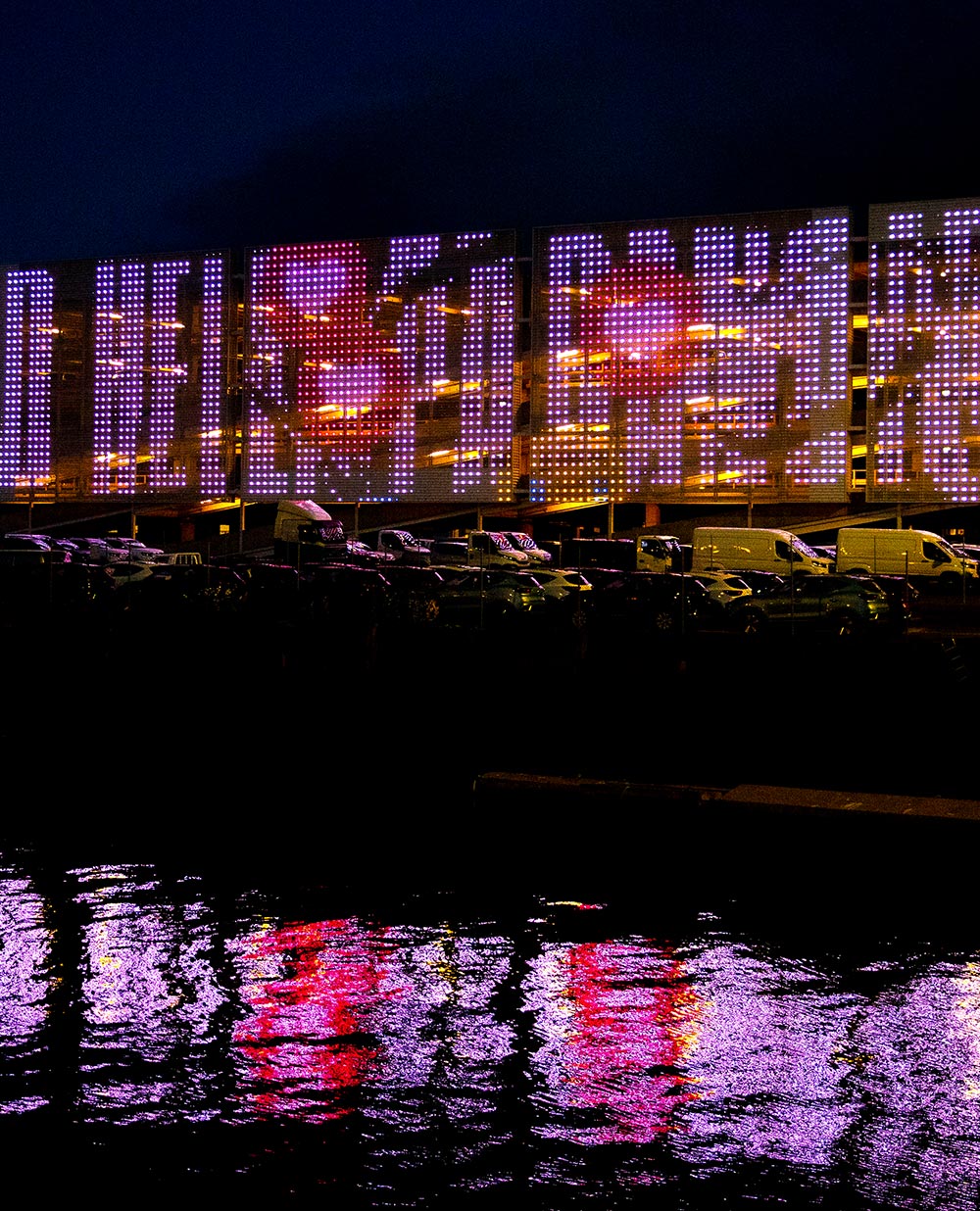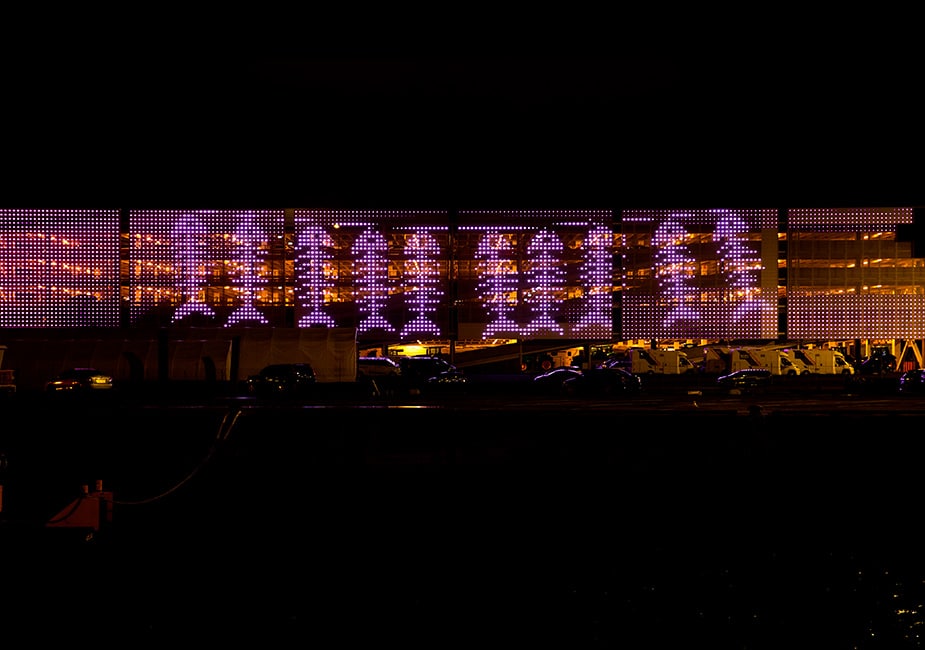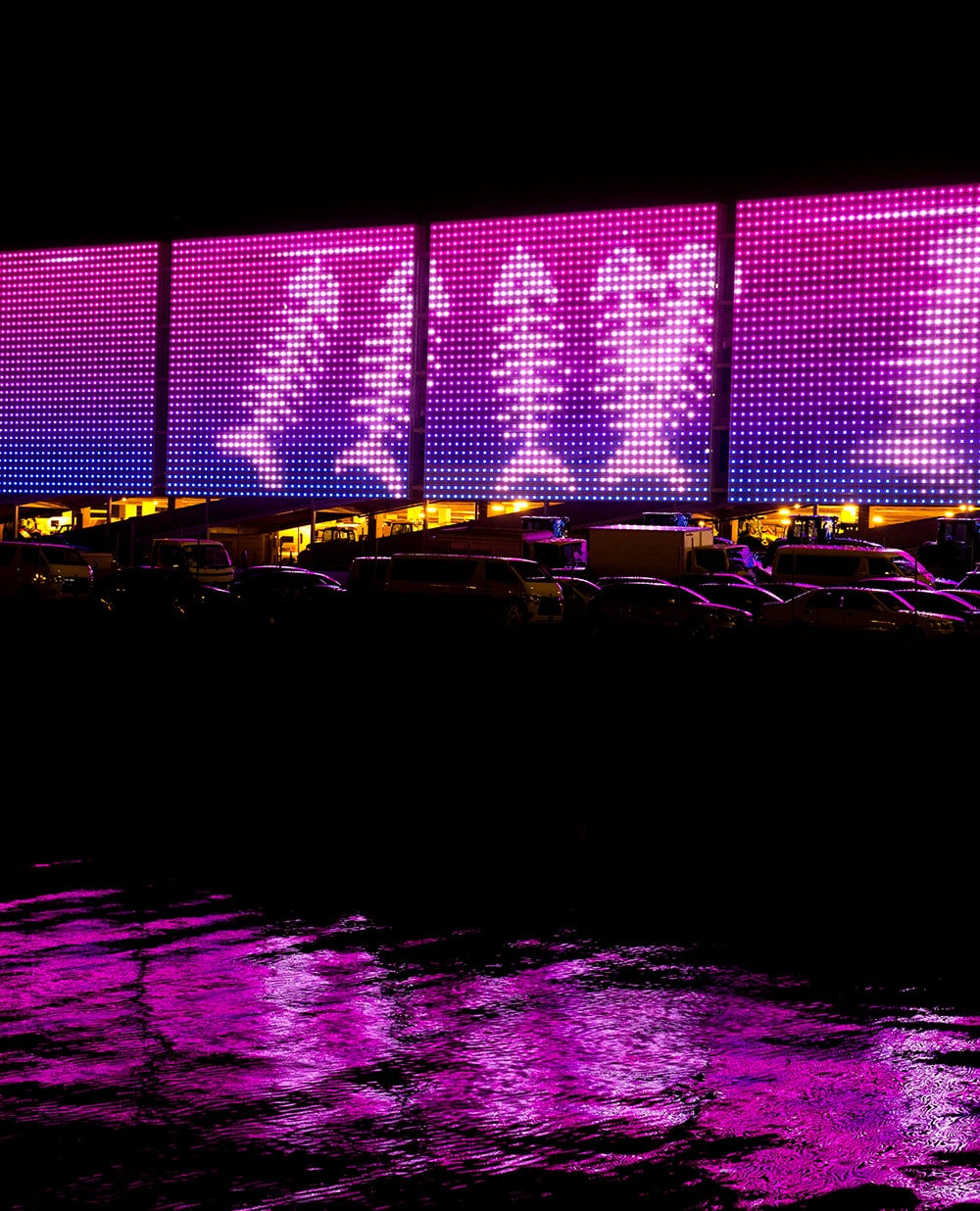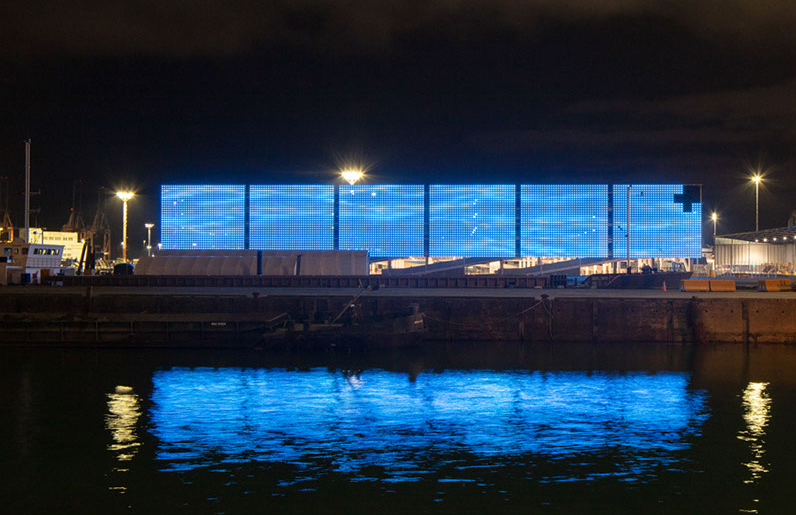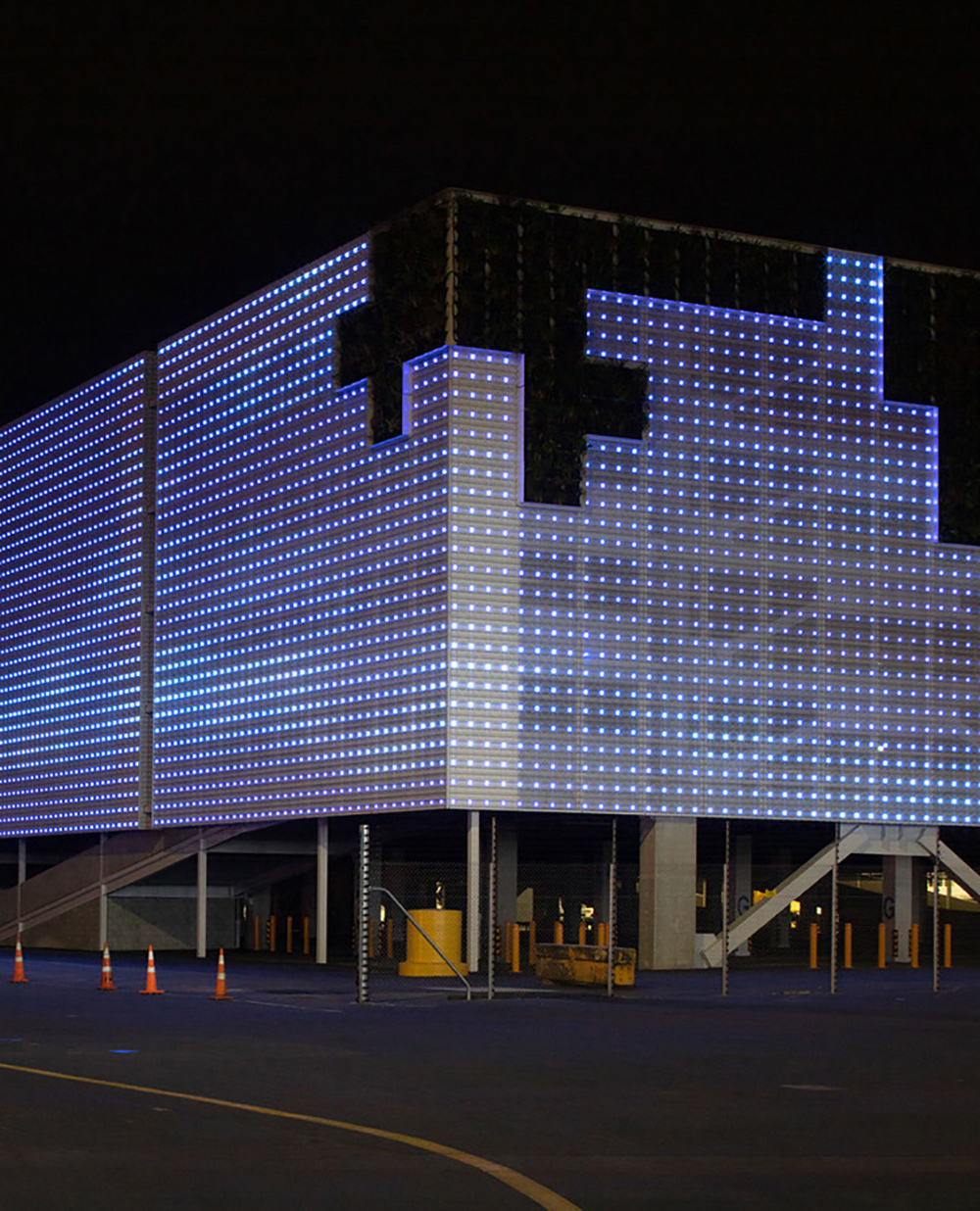Bledisloe Wharf — Ports of Auckland
13 MAY-
9 AUG
2024
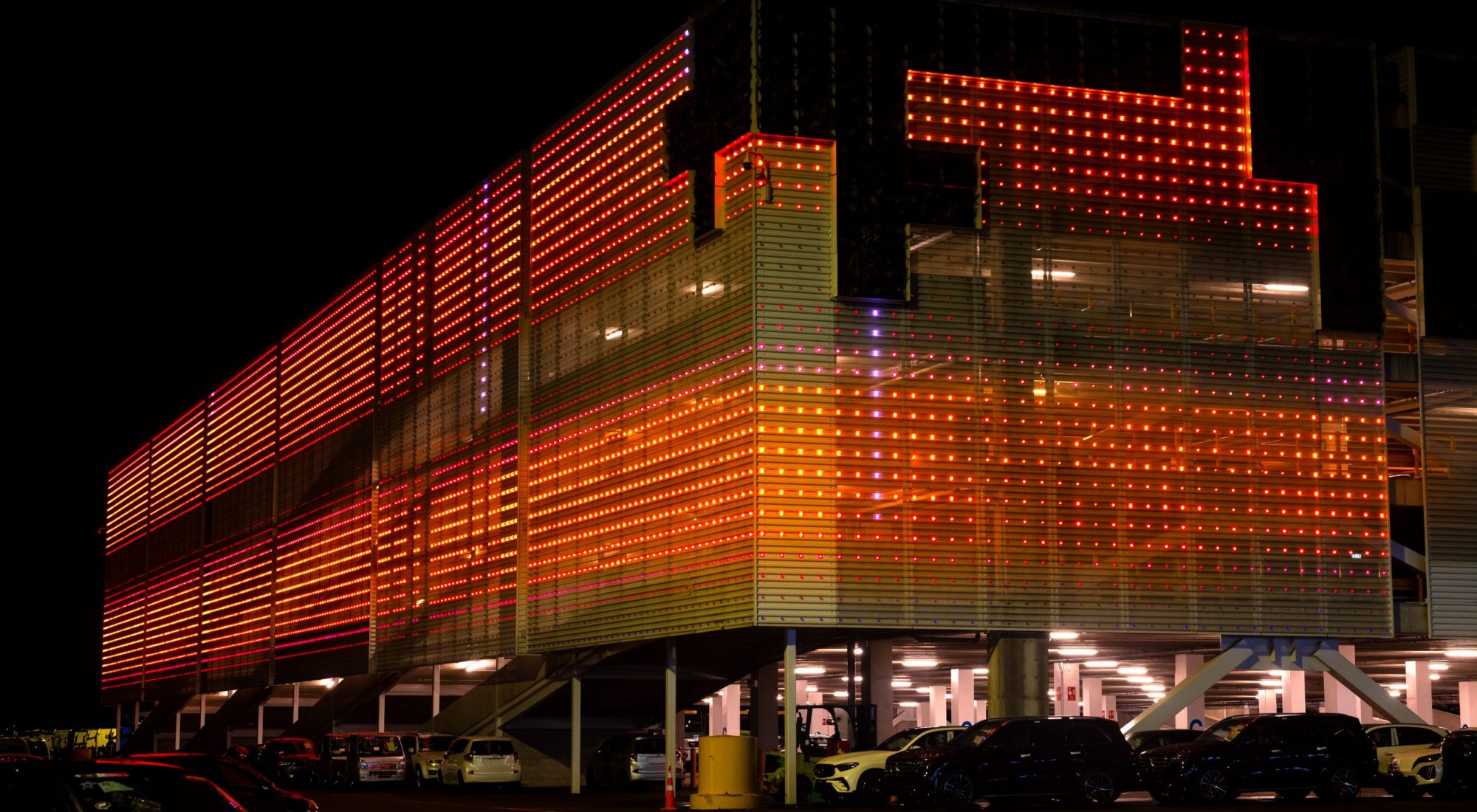
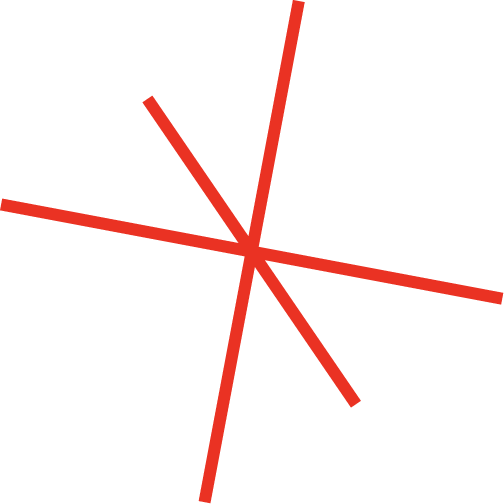
In Clinton Watkins’ Frequency Colour, bands of coloured light, patterns and undulating swathes of seemingly-random visual noise pass over the screen like capricious, technological weather.
Watkins works across audio-visual installation and experimental music and has been producing, exhibiting and performing his work for over 20 years throughout New Zealand, Australia, Europe, Asia and the United States. Clinton has a Doctorate in Fine Arts and is Programme Director at AUT’s School of Future Environments.
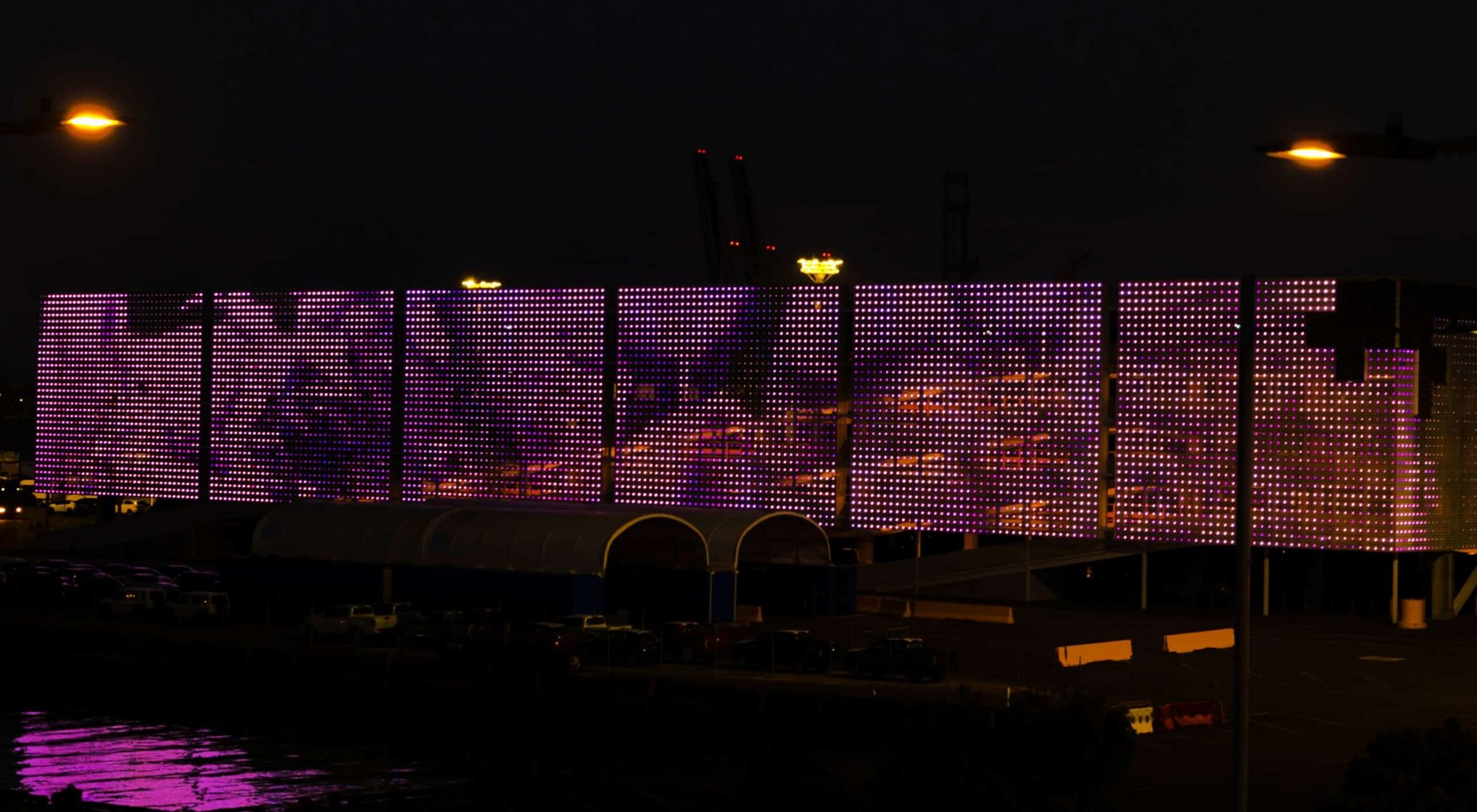

This piece is part of an ongoing series of works by André Hemer that focuses on the idea of materiality in relation to digital space by using 3D scans of sculpted paint elements to create rotating digital forms or intersecting groups of enigmatic objects.
André Hemer’s works explore the intersections between digital media and painting. His interest in sampling digital media—including scans, found digital images or systems, and digital drawings—is born out of a desire to synthesise the concerns of the post-internet age with more traditional methods and techniques. Hemer’s work has been exhibited widely, with solo presentations at the Kristin Hjellegjerde Gallery; COMA Gallery, Sydney; LUIS DE JESUS, Los Angeles; Gow Langsford Gallery, Auckland; Yavuz Gallery, Singapore; and Chalk Horse Gallery, Sydney.
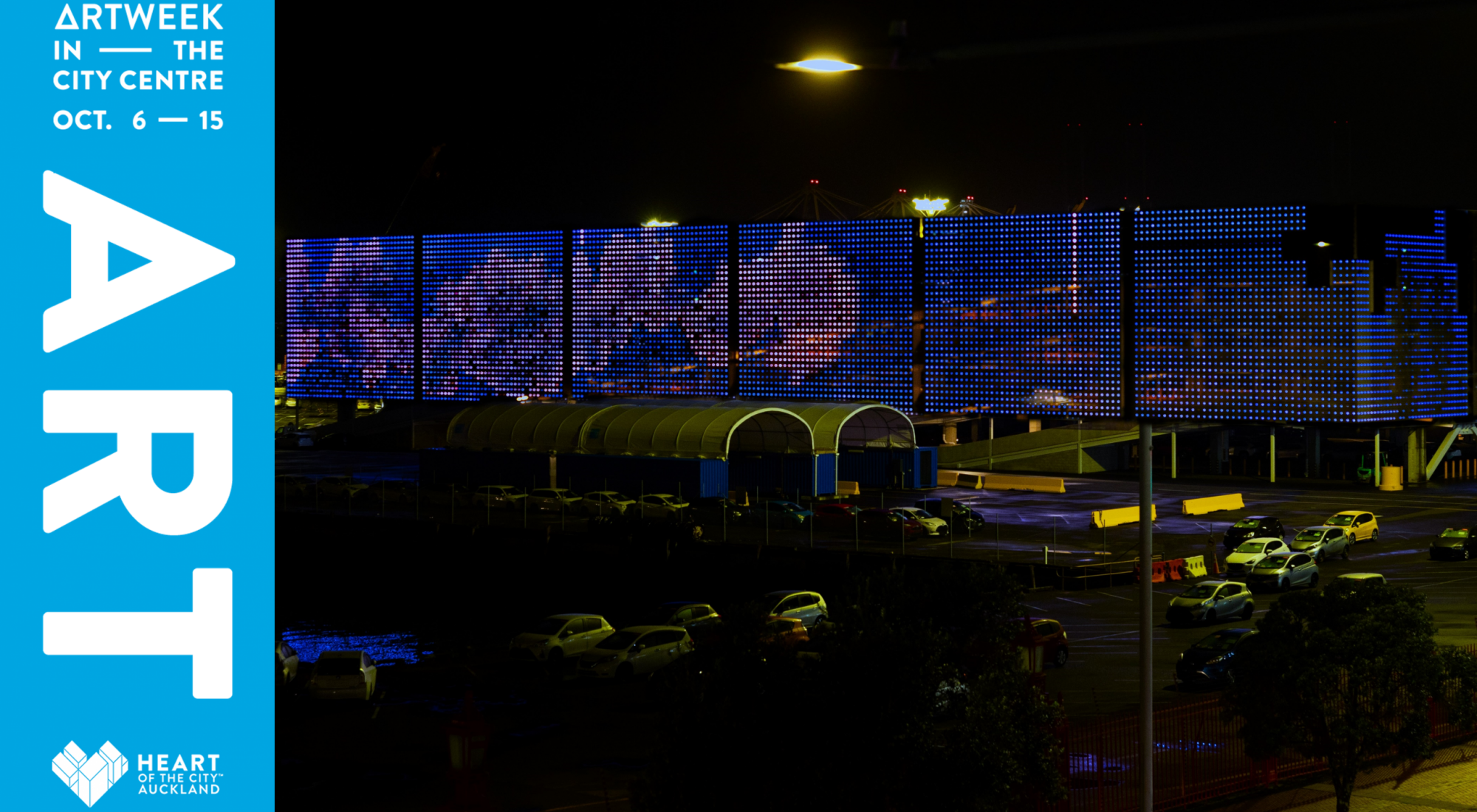


In Jae Hoon Lee's new work for The Lightship, A Long White Cloud, a scrolling band of clouds drifts across an impossibly blue, sparkling sky. The work presents a panoramic window onto a sublime archetype of the sky-as-metaphor, symbolising freedom, release, salvation, and any number of other positively charged ideas.
Lee’s digital photographs, video installation and sculpture have been exhibited widely in New Zealand and internationally over the past fifteen years, and acquired for both public and private collections. Jae Hoon Lee's piece is part of Artweek in the Auckland city centre taking place from October 6-15, with over 50 pop-up exhibitions, galleries, laneway installations, free art walks and more.
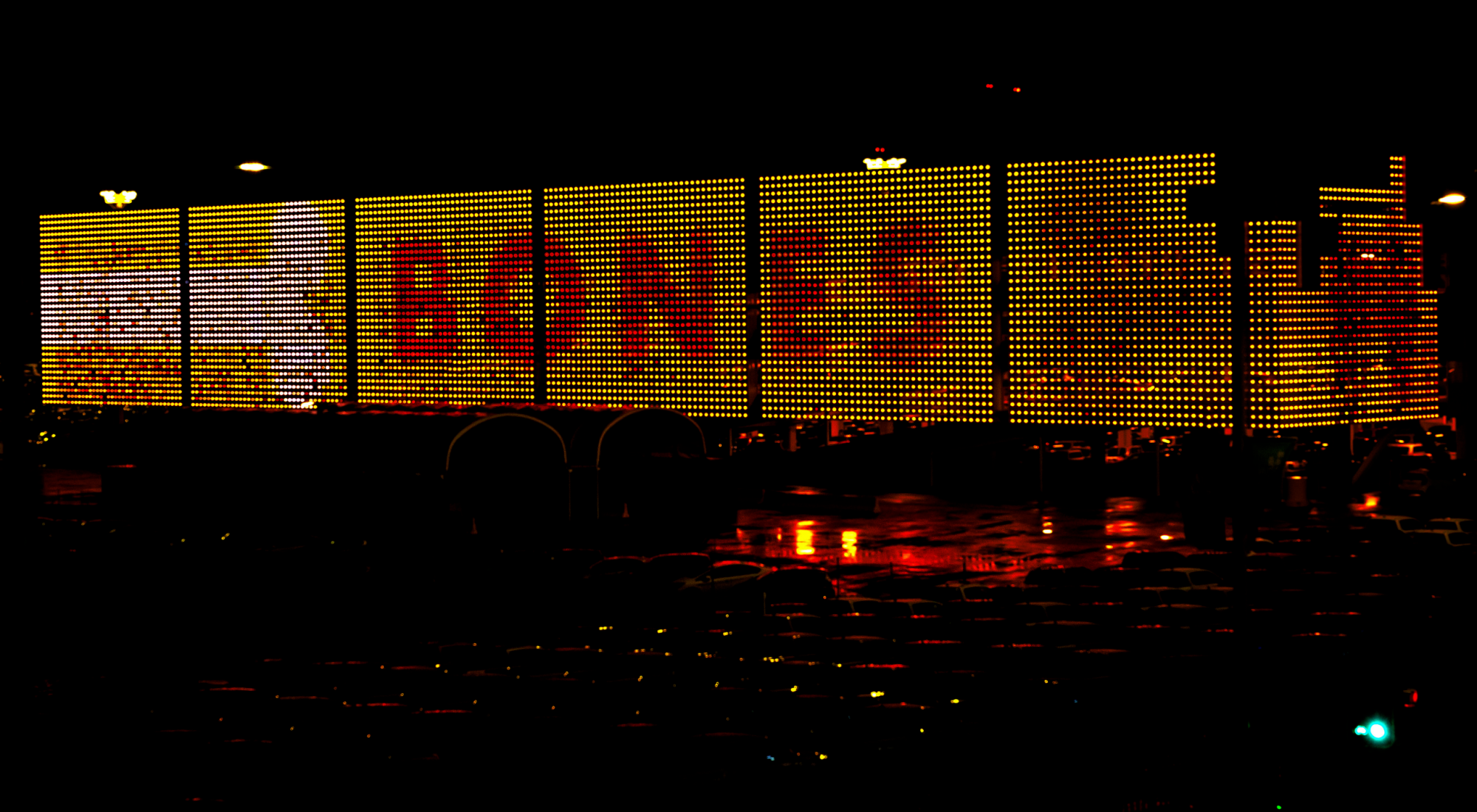

In Heavy Frame (WAIRUA), the work’s text content, which reads “YOUR BONES ARE STRONG LIKE MINE :)”, suggests connectivity or reciprocity. Being installed on Matariki, a time to remember and pay respect to those who have passed away, this work also has a monumental or tributary quality. As the two-part title suggests, the work juxtaposes the solidity of bones-as-momento-mori with the idea of a soul or quintessence that outlasts the physical form, playfully inserting itself into commonplace narratives about death, dying and the afterlife
Turumeke Harrington is a Wellington based artist who works across sculpture and installation. Her practice is characterised by bold colours and references to domestic forms and materials. Sitting somewhere between art and design she is interested in exploring how objects, material and colour can subvert, challenge and express mātauranga Māori.
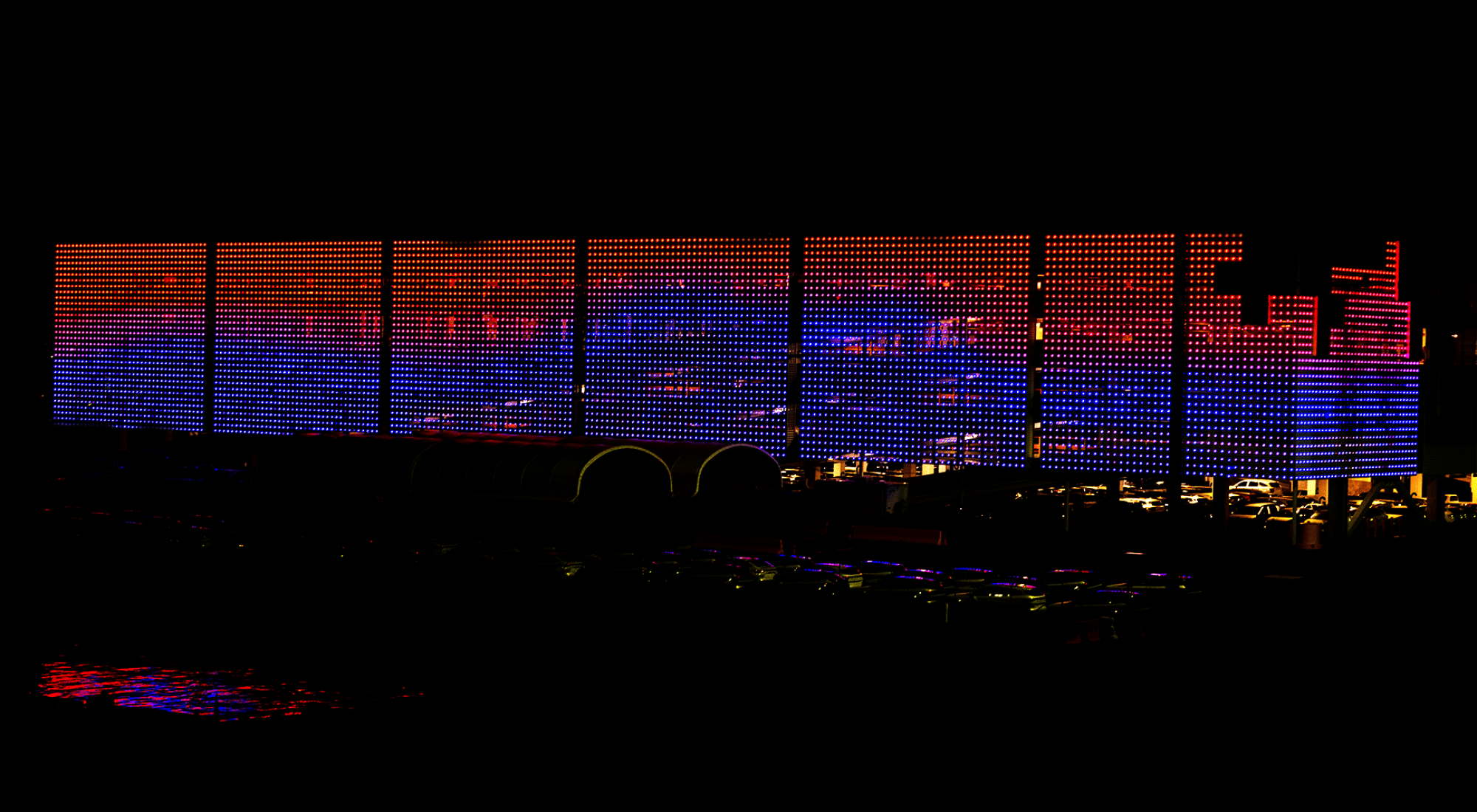

In Emma’s Rain, Andrew Beck brings the themes and ideas that permeate his photogram and installation practice to the macro-scale video format of The Lightship. In Emma’s Rain, footage shot using a thermal-imaging camera is cropped and manipulated to produce a mirage-like terrain of shifting colour and flowing, organic shapes.
Andrew Beck lives in Wellington, New Zealand. Beck continues to exhibit widely in New Zealand and overseas and his works are held in major public and private collections both nationally and internationally. In November 2019 he was awarded an artist-in-residence at the Robert Rauschenberg Foundation in Captiva, Florida.
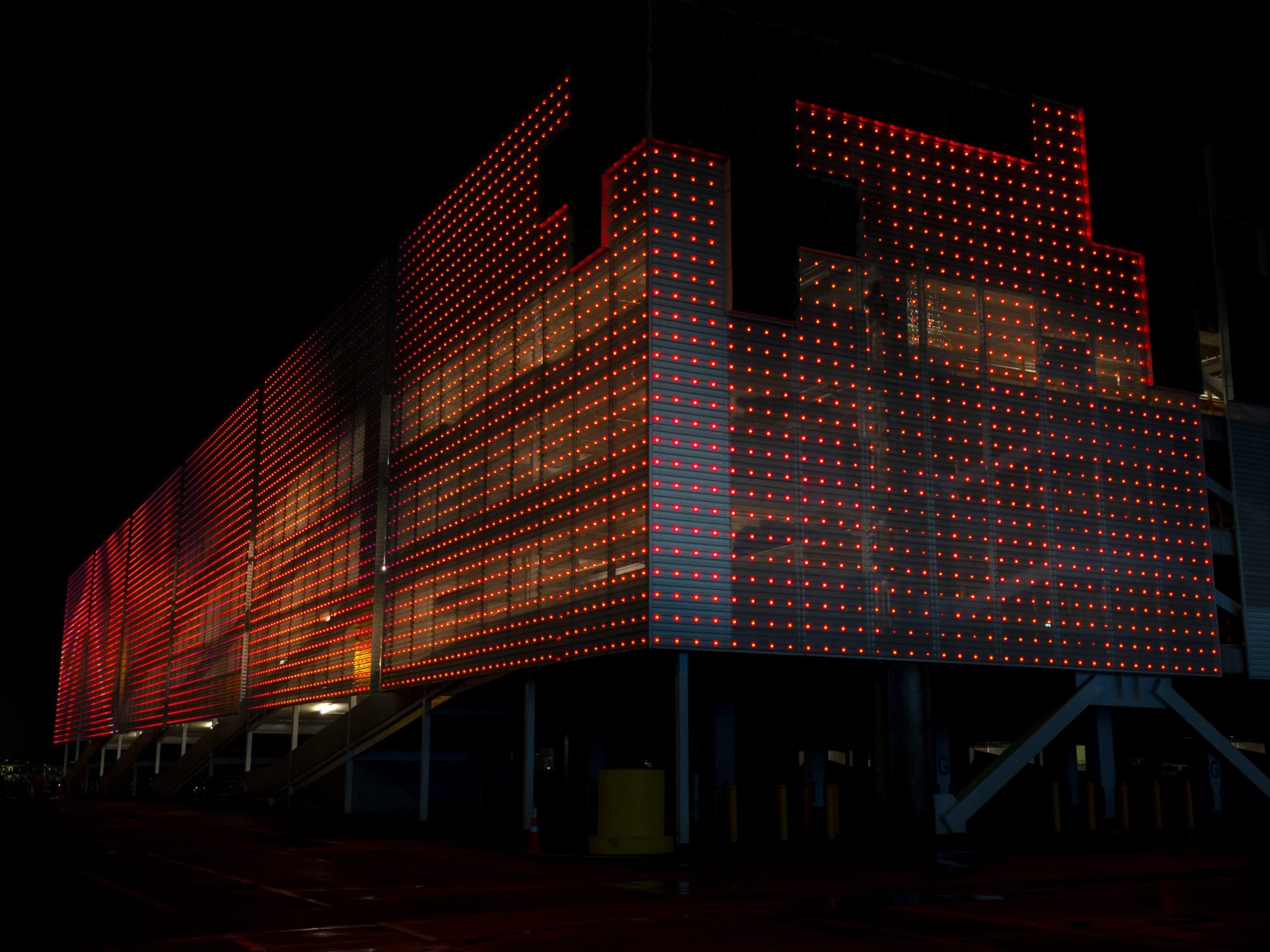

Sonya Lacey’s new site-specific video for The Lightship presents footage which pans over a red-hued array of plants and vegetation. The extreme close-ups highlight slight movements of plants in the breeze, giving them an animated, dynamic quality, while the measured slow pace of the camera feels exploratory, or even voyeuristic. Equal parts clinical and hauntingly atmospheric, this footage was captured using a camera shooting at the 680 nanometre wavelength, or the near-infrared part of the visible spectrum.
Chlorophyll (Port of First Arrival)builds on previous works in which Lacey connects the physiological needs of plants with those of humans, and with a broader idea of how time is experienced via the rhythms of the body.
Sonya Lacey lives in Tauranga and works in a range of media including moving image, sculpture and language. In 2021 she was the Dunedin Public Art Gallery Visiting Artist, a residency that culminated in the one-person exhibition Totally Dark. Her exhibition Weekend was nominated for the 2021 Walters Prize and exhibited at Auckland Art Gallery Toi o Tāmaki. She has exhibited throughout Aotearoa at multiple galleries. Her moving image works have been exhibited internationally including at the State of Motion Festival of Moving Image, Singapore and the London International Film Festival. She has undertaken a number of international residencies, most recently with NTU CCA Singapore. Sonya is represented by Robert Heald Gallery, Te Whanganui-a-Tara Wellington.
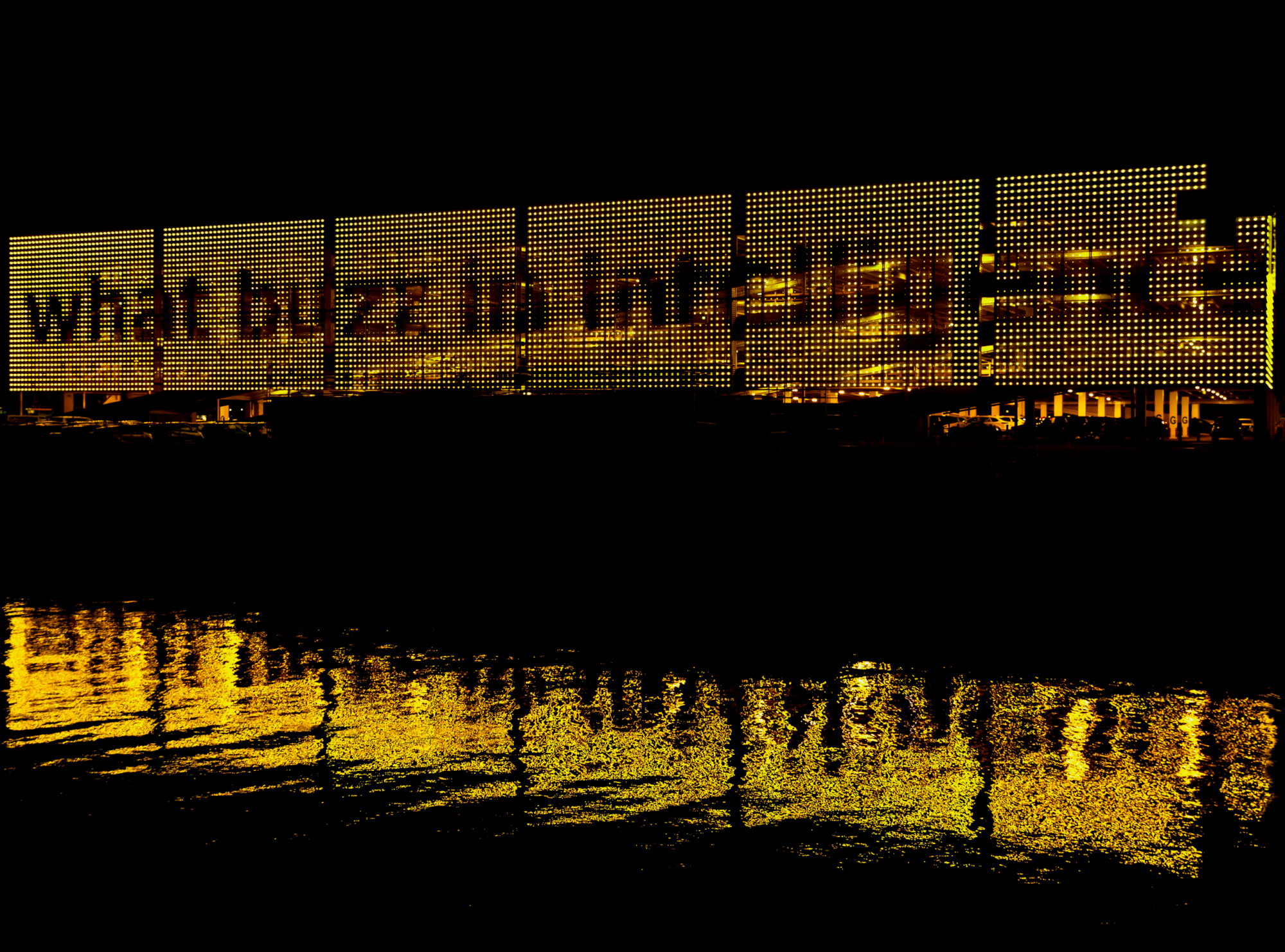

In A Random Rant, Sean Kerr randomly selects snippets of bold text, which pops into view in rapid-fire succession, a bewildering stream-of-consciousness, barrage of buzzwords, chatty comments, and ‘90s-style emojis.
Like much of Kerr’s work, A Random Rant’s vocabulary is familiar staples of recent discourse, both public and private, while others are non-sequiturs (achoo, squish, arrrt) and some are merely banal (shoes, tie, dog).
This cavalcade of linguistic data-points, flicking onto The Lightship with the relentless pace of an excited teenager’s instant messages, serves ultimately not to construct a conversation or serve an ideology, but to undermine the premise of communication itself.
Sean Kerr lives and works in Auckland, New Zealand, where he is a Senior Lecturer at Elam School of Fine Arts, University of Auckland. He is the Programme Leader for the Fine Arts Doctoral Programmes, specialises in Real-time 3d, VR and interactive technologies, and has produced two books; ‘Bruce is in the garden, so someone is in the garden’, and ‘Pop’. Both were published by Clouds publishing.
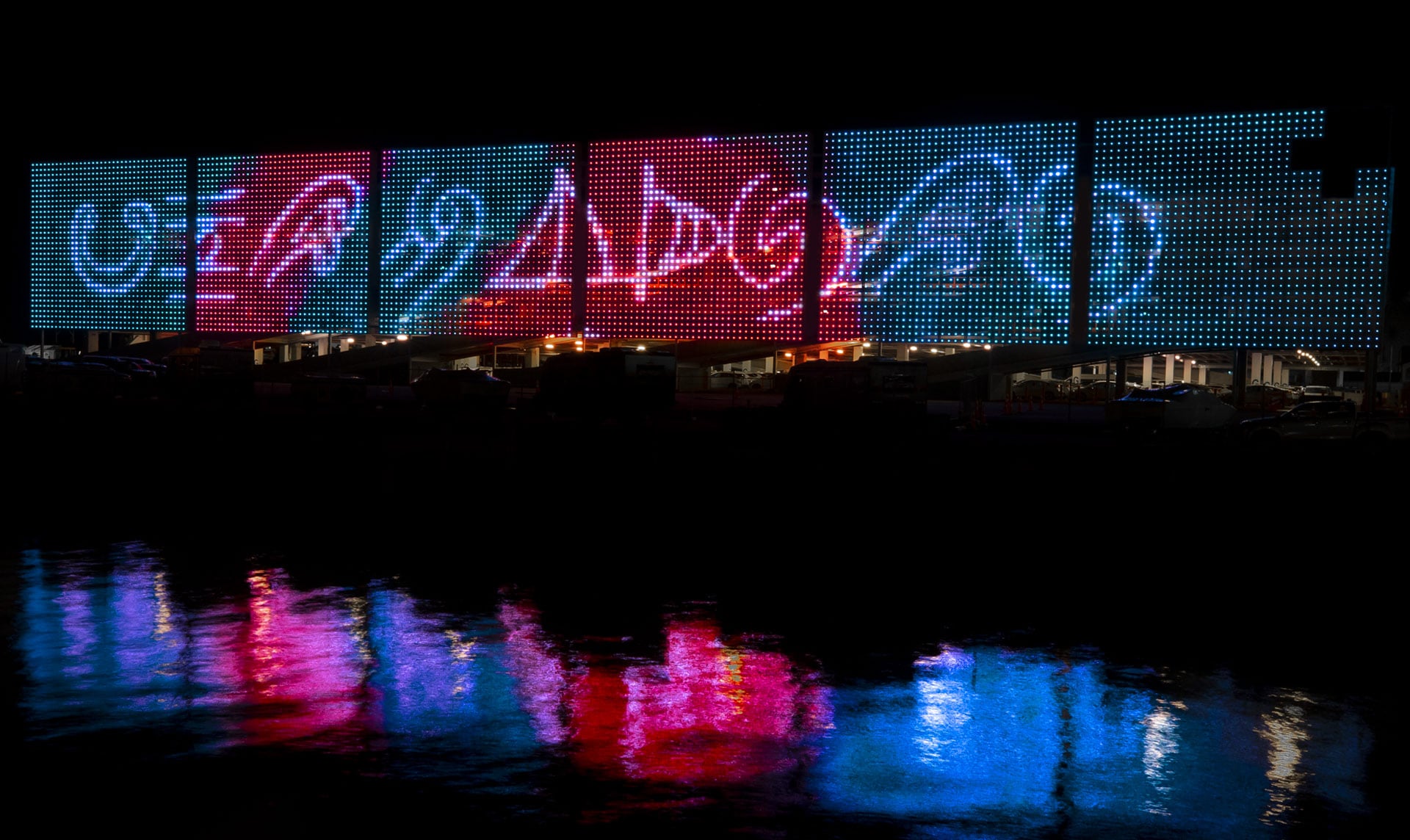

Hinemoana & Papatūānuku tells of the formative and sustaining relationship between earth and ocean – atua.
Written, painted, and spoken at a point of their meeting, the artist gives shape to the deep identity of place: environmental expression honoured in the careful drawing of the symbolic.
Language defines and limits the world we put it to. Ocean and Earth. Hinemoana and Papatūānuku. Words resist and reinstate.
essa may ranapiri (they/ia | Ngāti Wehi Wehi, Ngāti Raukawa, Te Arawa, Waikato-Tainui, Ngāti Pukeko, Ngāti Takatāpui, Clan Gunn) is primarily a poet, but also dabbles in visual arts.
They have a great love for language, LAND BACK and hot chips. Their first book of poetry, ransack, was published in 2019. ECHIDNA is their second book.
Photography: Brett Phibbs
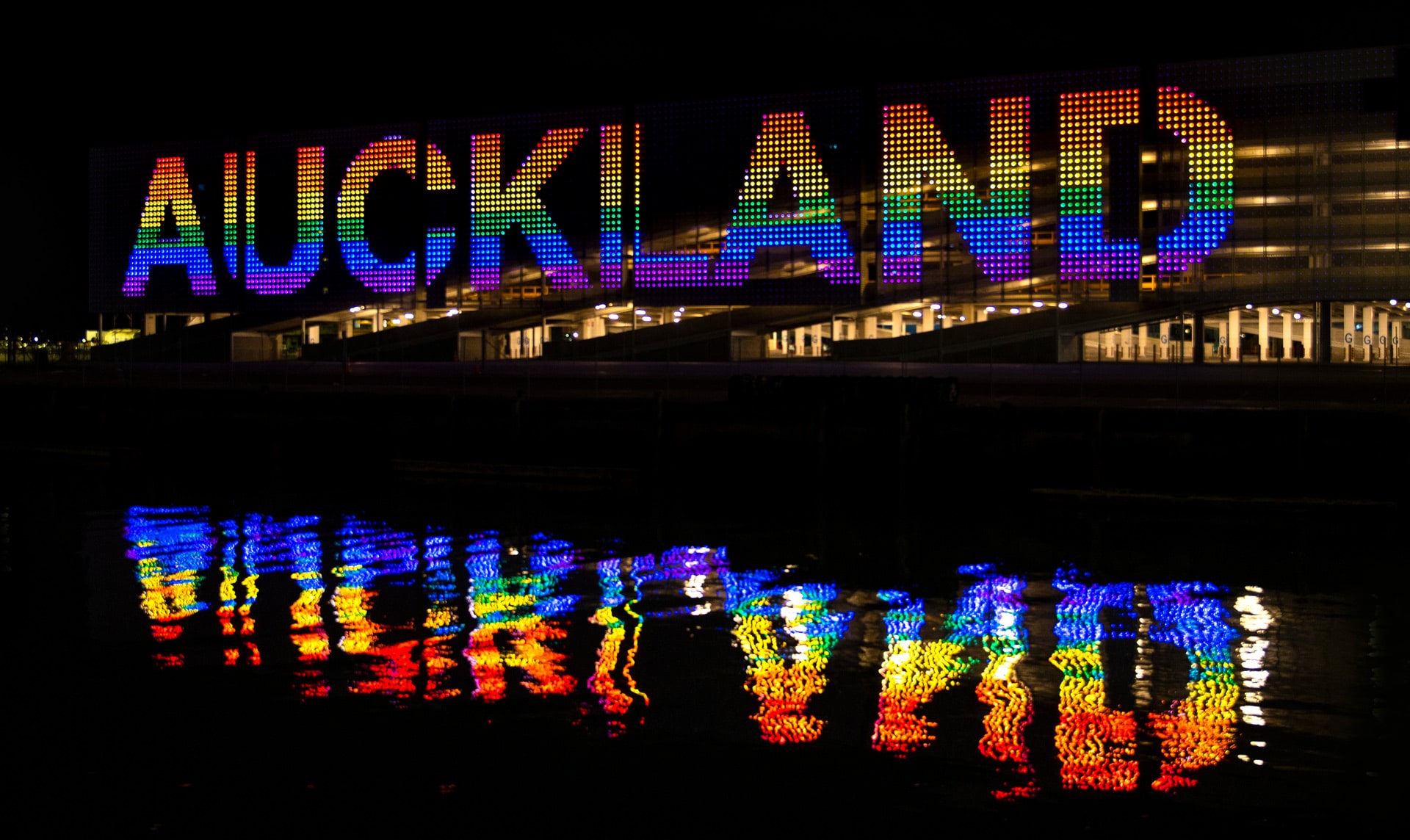

Extending Parasite’s original critique concerning the lack of queer representation in art galleries, director Daniel John Corbett Sanders’ new work reflects on the use and misuse of LGBTQ+ representation in advertising.
Broken Sovereignty will be accompanied by a series of discussions with Sanders around issues of LGBTQ+ representation.
Daniel John Corbett Sanders is a Pākehā artist and curator from Ngāmotu New Plymouth, Aotearoa New Zealand, of Dutch and Ashkenazi descent. He majored in sculpture, and has studied at Elam School of Fine Arts, University of Auckland and Auckland University of Technology. www.danieljohncorbettsanders.com.
Photography: Brett Phibbs
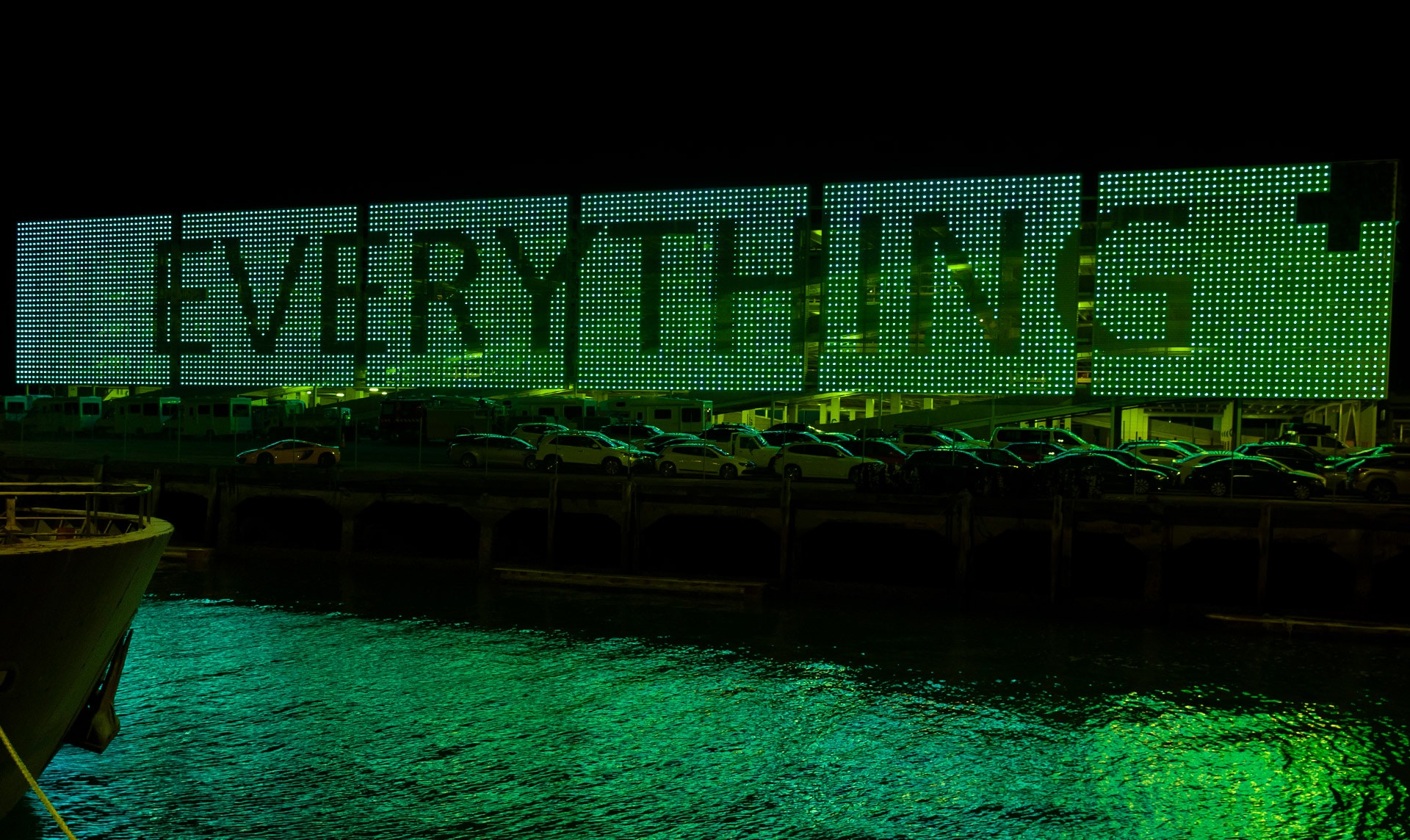

Fiona Jack’s new work reflects on global change in the 25 years between Nothing™ and Everything. Jack’s new work on The Lightship references the 1997 campaign in its typography and imagery, but instead of many ‘nothings’ throughout the city, she offers one ‘everything’.
Everything, the single static word on The Lightship’s LED screen, is accompanied by a podcast — a prompt for public conversation with Fiona and friends.
Fiona Jack is an artist and educator based in Auckland, Aotearoa (New Zealand). Working in ceramics, textiles and social practice, her projects are driven by engagement with local communities and sociopolitical issues. Through dialogue, observation, collecting and digressive historical research Fiona pieces together a fabric of references that inform the development of each body of work.
Fiona has an MFA from CalArts Los Angeles and is Acting Head of School at the Elam School of Fine Art at The University of Auckland.
Photography: Brett Phibbs
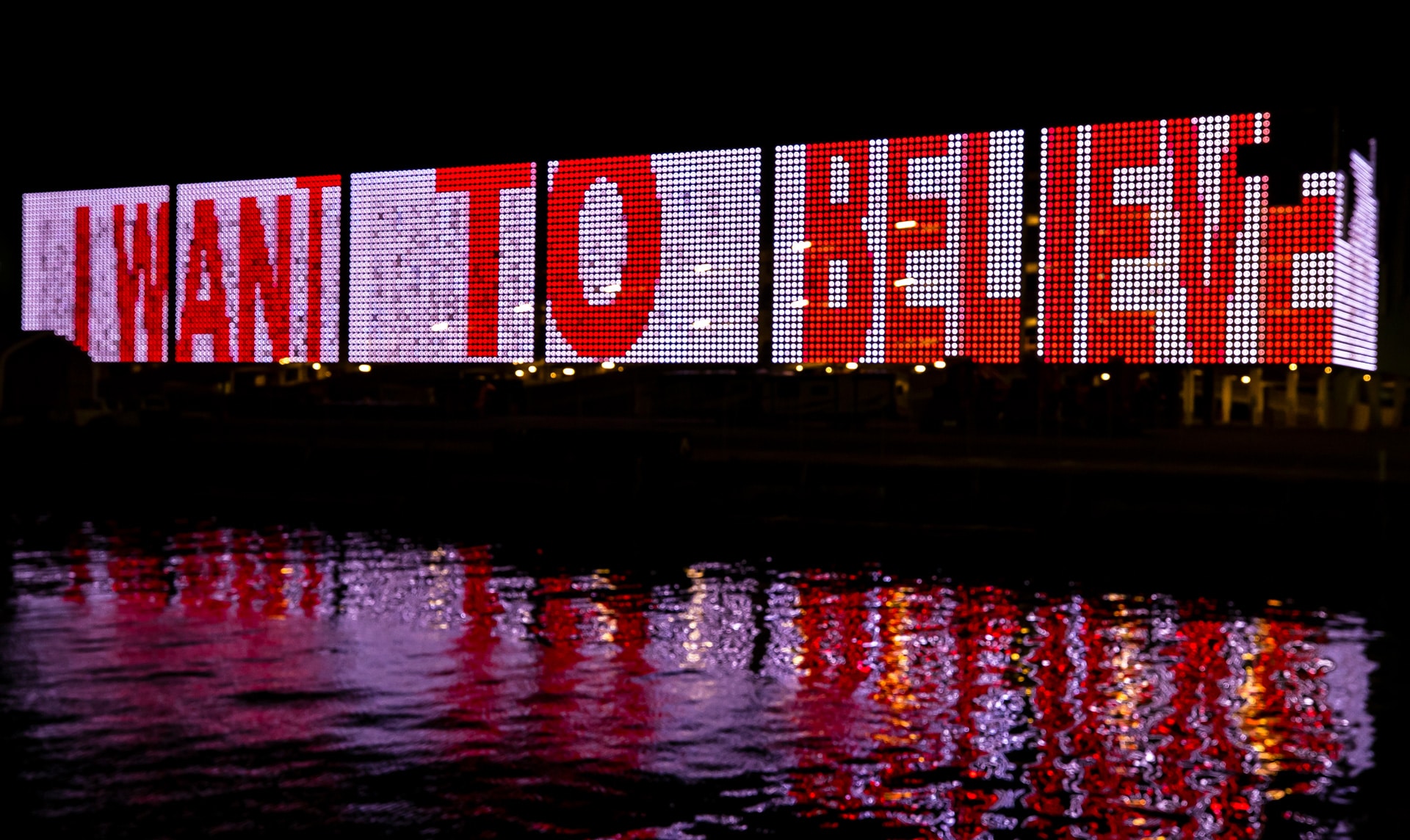

For SINŌ, the identity emerging from this archetypal encounter on the shore is ‘Kiwi’. Whakakiwi can be interpreted as ‘how to become a New Zealander’ or, ‘the making of the New Zealander’.
The usage of ‘Kiwi’ to name a person who lives in newzooland signals a belonging to a specific ideological new zmiddlearthland — one that has overcome its colonial beginnings of forceful nation building and control over indigenous life.
Breeded and birthed in Tāmaki Makaurau, this practice falls along the failures of a necropolitical factory of transgenderist-homoheterosexualising-monstrous-dissident-taniwha-of-the-western-binary-of-sexual-difference-and-an-enemy-of-the-country-colony-and-crown.
Photography: Brett Phibbs
Kupesi Sisi Huelo ‘oe Taulanga Waitematā moe Funga Tāmaki Makaurau (2021)
(Download) Press release*
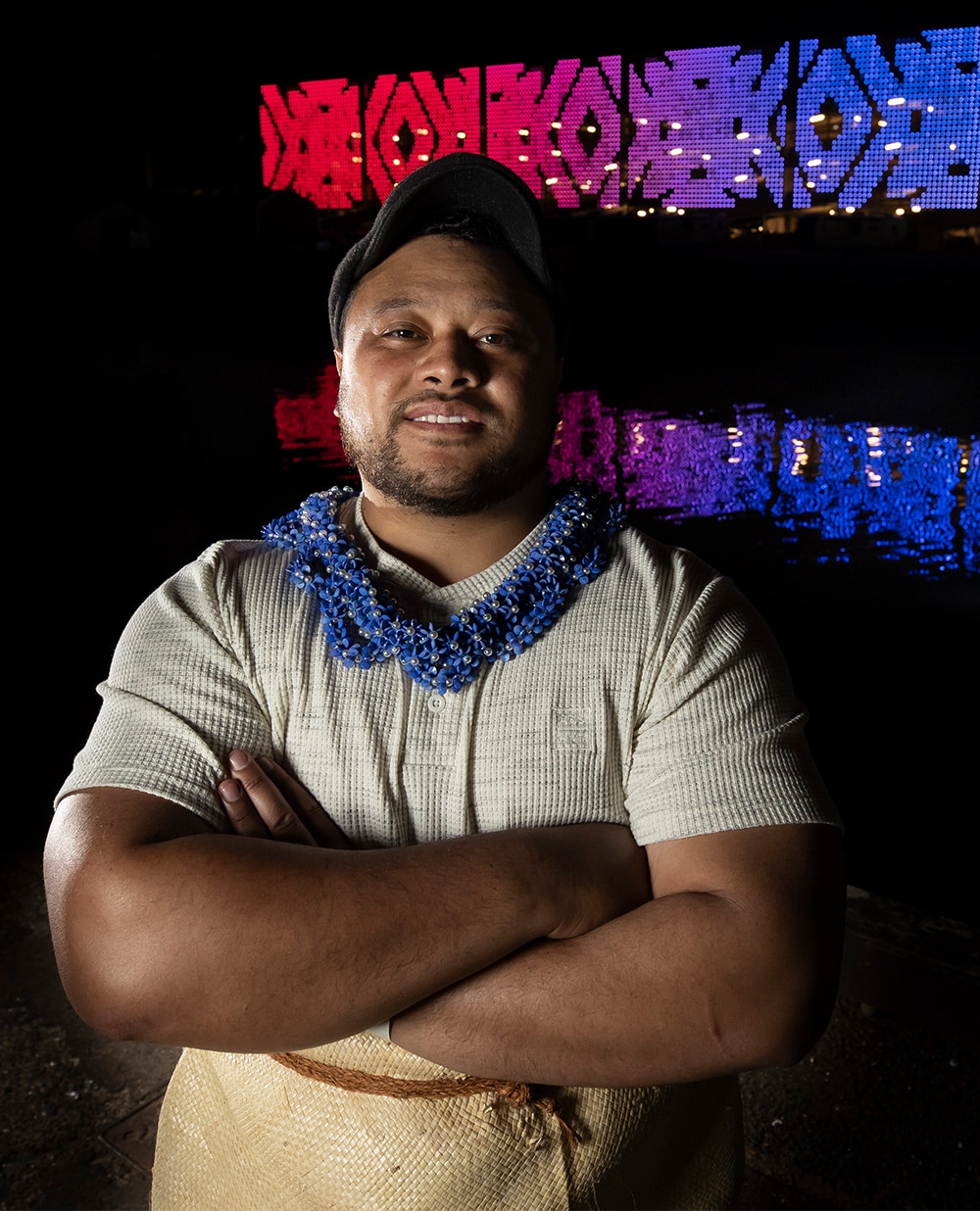
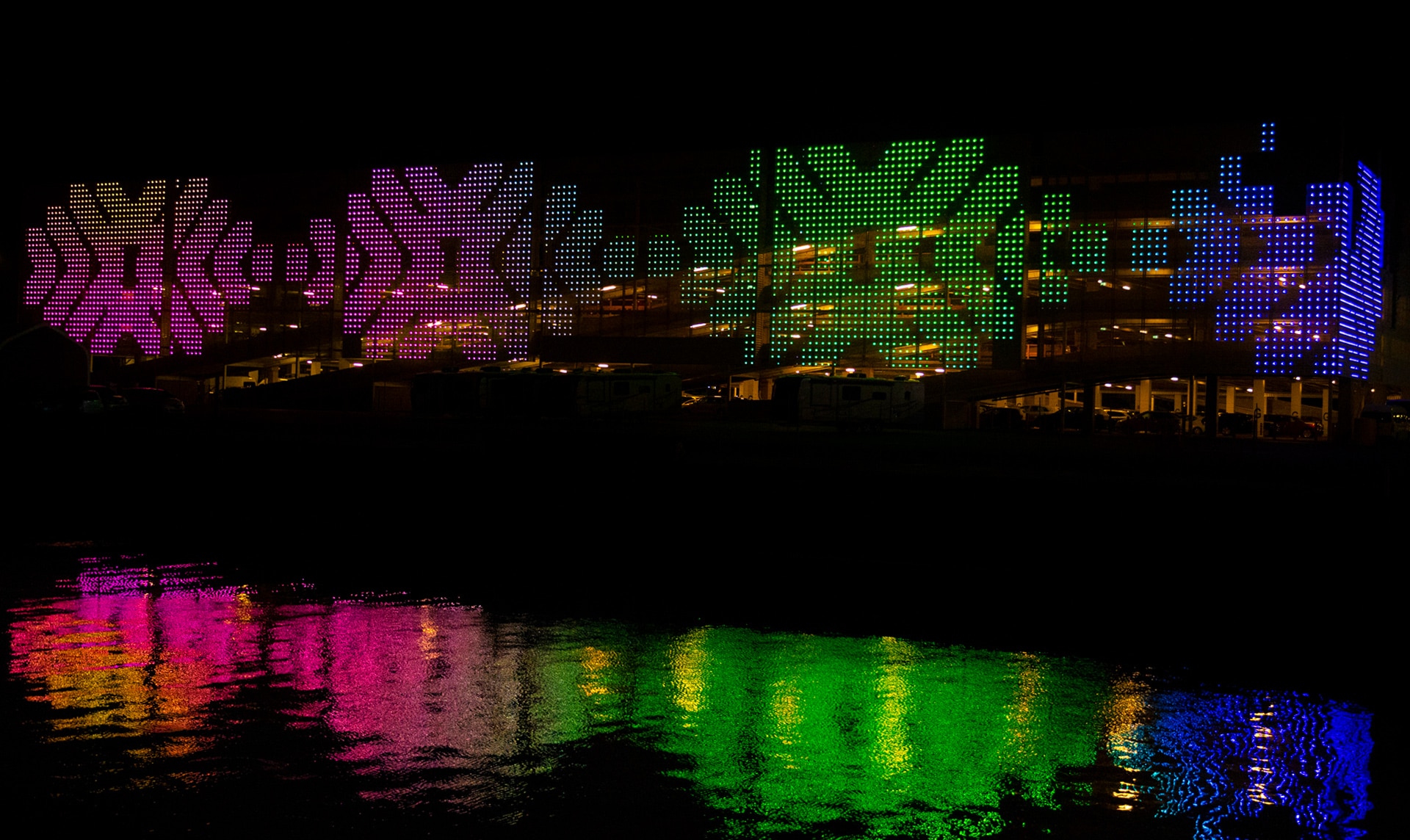

Emitting its light onto the water and into the environment, Kupesi Sisi Huelo ‘oe Taulanga Waitemata moe Funga Tāmaki Makaurau adorns The Lightship, harbour, and city. A sisi (garland) of light beams (huelo), this patterned adornment was created from and for the spaces of the port and its surroundings.
Extracted audio wave spectrum from sounds recorded at the Ports of Auckland, the Waitematā Harbour and Auckland CBD provided the artist with high, medium and low frequencies. Generating visual patterns from this raw sonic material, the artist reimagines these spaces through the sense of listening.
Sione Faletau is a multidisciplinary artist born in Auckland with Tongan heritage. Utilizing art as a vehicle to explore his heritage has led him to undertake Doctoral research on Tongan masculinity from an Indigenous perspective. As of late, his interest has been in creating kupesi (patterns) from extracted audio waveforms from songs, audio recordings and field recordings of environments.
The audio waveforms give him a material that can be manipulated into kupesi. This innovative way of creating has opened a new language and a different way of seeing kupesi in the contemporary realm.
Photography: Brett Phibbs
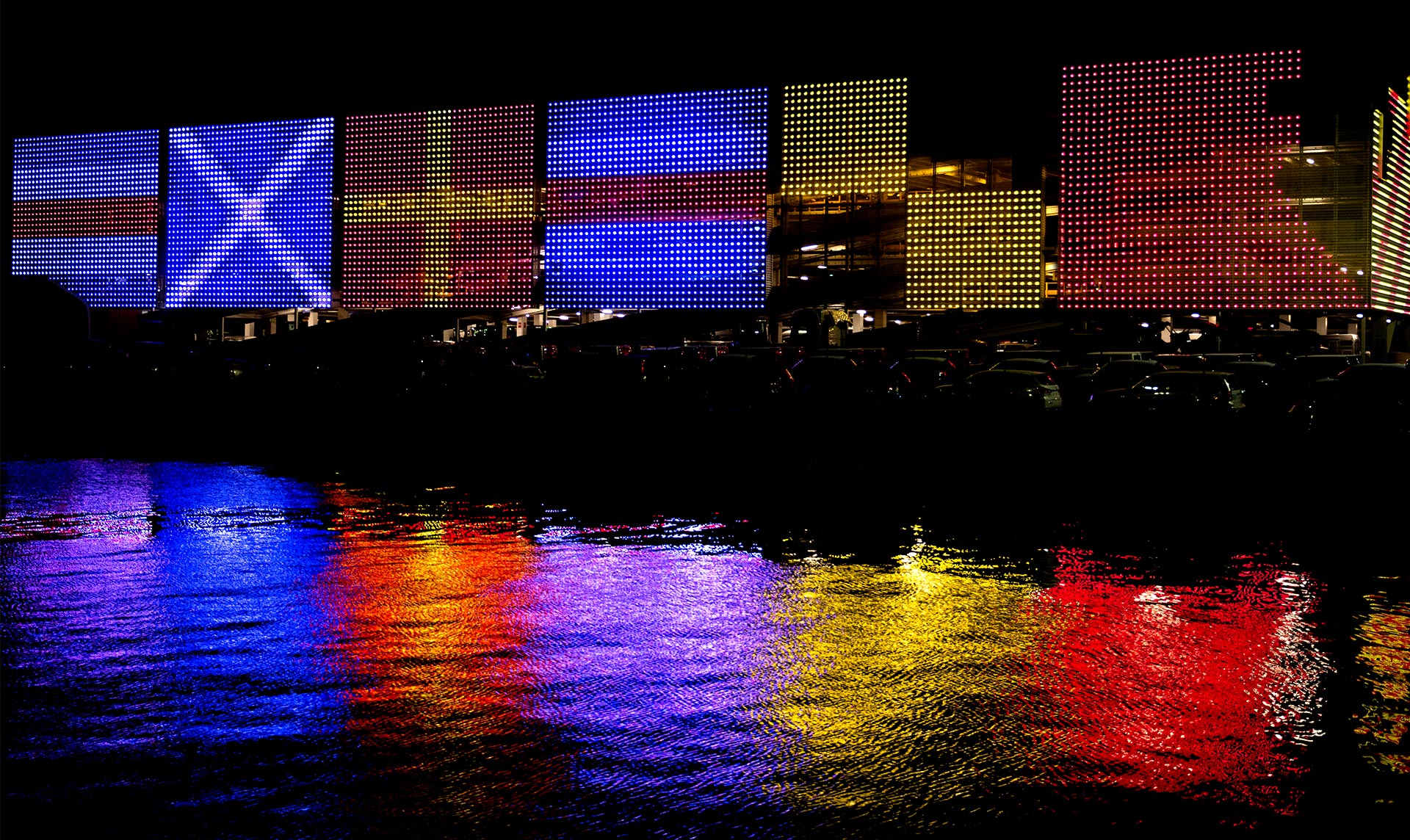

Composing together numerous languages of the Waitematā and its shoreline, Onepanea looks at the communication of and in a place as a force that can both define it in meaning and physically shape it.
Assembling languages that are human, nonhuman, those in everyday use and those less in currency, Onepanea works through a linguistic strata of the Lightship’s place.
Natalie Tozer is an artist and experimental filmmaker based in Tāmaki Makaurau. Working closely with behaviours of ‘the underground’, her process often involves burying and unearthing objects and information. Recent shows include Emerging Artists Show at Sanderson Gallery, Salted Earth at Sosage Gallery and Goofer Dust at Elam Project Space.
In 2021, her work was selected for Femisphere 4 and was a National Contemporary Award Finalist. Natalie holds a PGDipFA with distinction and is a MFA candidate at Elam School of Fine Arts.
Sam Tozer (Kāti Māmoe, Pākehā) is a co-director of LOT23 – a film studio, gallery and live music events centre. He is also a long time collaborator of Lisa Reihana, being her DOP / Technical director / VFX / compositor for Ihi installed at the Aotea Centre in 2020, Nomads of the Sea 2019 and In Pursuit of Venus {infected} which represented New Zealand at La Biennale di Venezia 2017.
With over 20 years experience, directing, editing, creating visual effects and shooting for music videos, drama, advertising and fine art projects he is pleased to collaborate for the first time with another creative force in his life; his co-director at LOT23, wife, mother of children, and writer of bio's Natalie Tozer.
With special thanks to Te Reo consultant Kiriana O’Connell (Ngāti Tukorehe, Pākehā)
Photography: Brett Phibbs
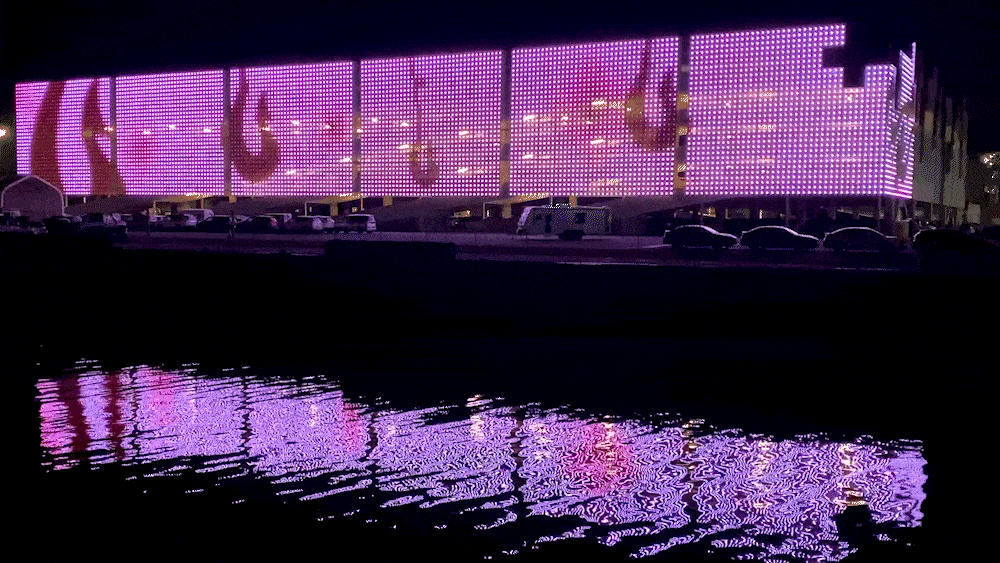
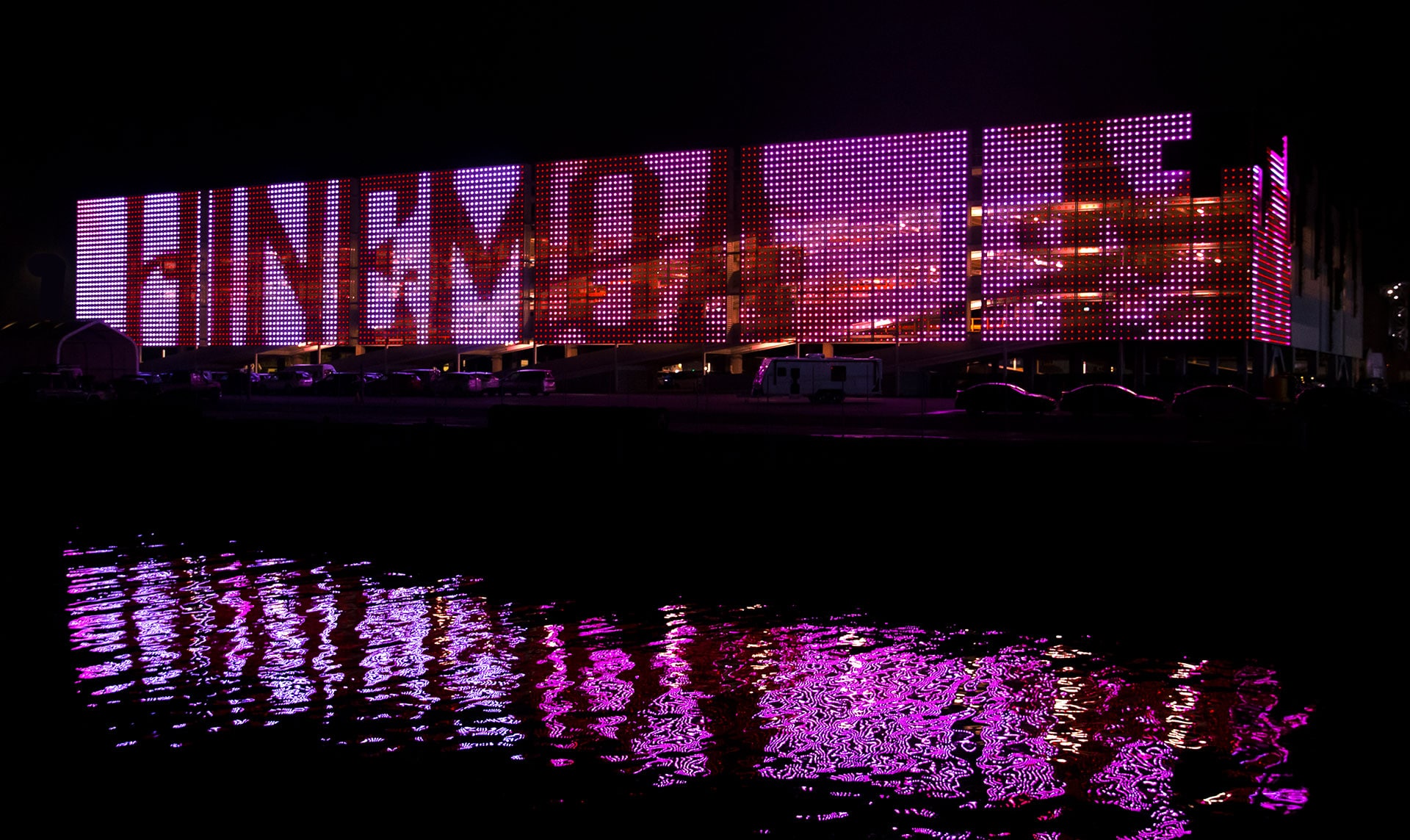

Lucy, Kathleen, Katherine, Karen, Hinemoa, Maata, Marina, Lily, Carlotta, Miringa, Agnes, Loretta, Abigail, Elizabeth, Hori, Sonny, Tataingaoterangi, Andrew, Georgina
Pūtahitanga kura opens with this list of names. They are whānau, ancestors, and literary figures; a constellation of identities whose names have graced, confined, or augmented self-hood. Names that arrive to us presently having gathered the events, losses, and meanings of those who bore them.
Based in Tāmaki Makaurau, artist Abigail Aroha Jensen recently graduated with honours from Toihoukura School of Māori Visual Art and Design in Turanganui-a-kiwa.
Recent work includes Ngā Haki o te Tangata; Whiri Whiri Muka Tangata (2020), Occupied Territories at RM Gallery with Avigail Allan and Naomi Allan (2021).
Based in Turanganui-a-kiwa, Georgina Watson is an artist and writer, graduating with a Masters in Fine Arts from Elam School of Fine Arts, and a Bachelor of Media Arts Majoring in Painting and Sculpture at Wintec.
Recent work includes the group show They Covered the House in Stories, curated by Amy Weng for Te Tuhi (2021), Eternal Girlhood of the Settler State, presented by May Fair Art Fair in collaboration with Tyson Campbell (2020).
With special thanks to Design Technician, Jim Haung.
Photography: Brett Phibbs
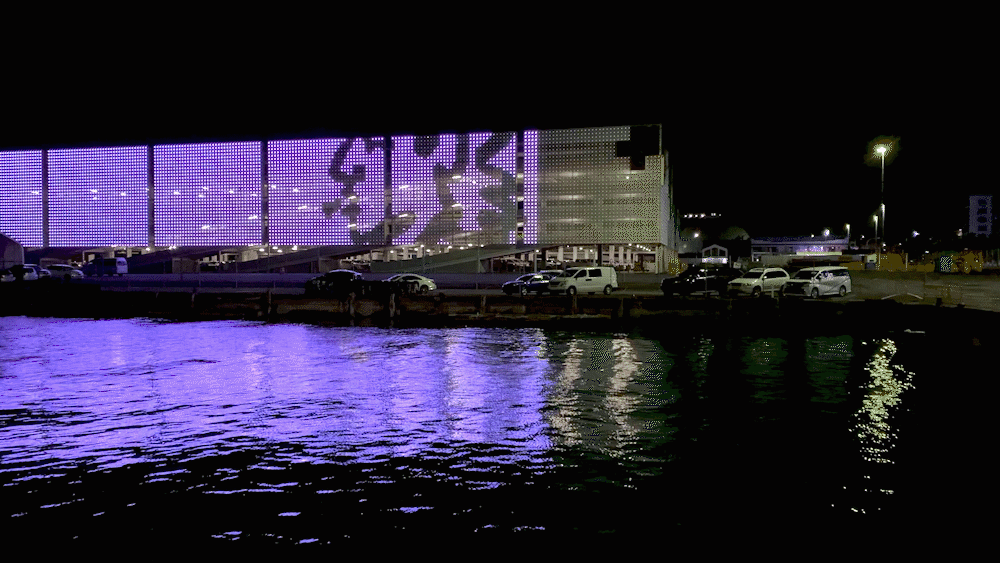
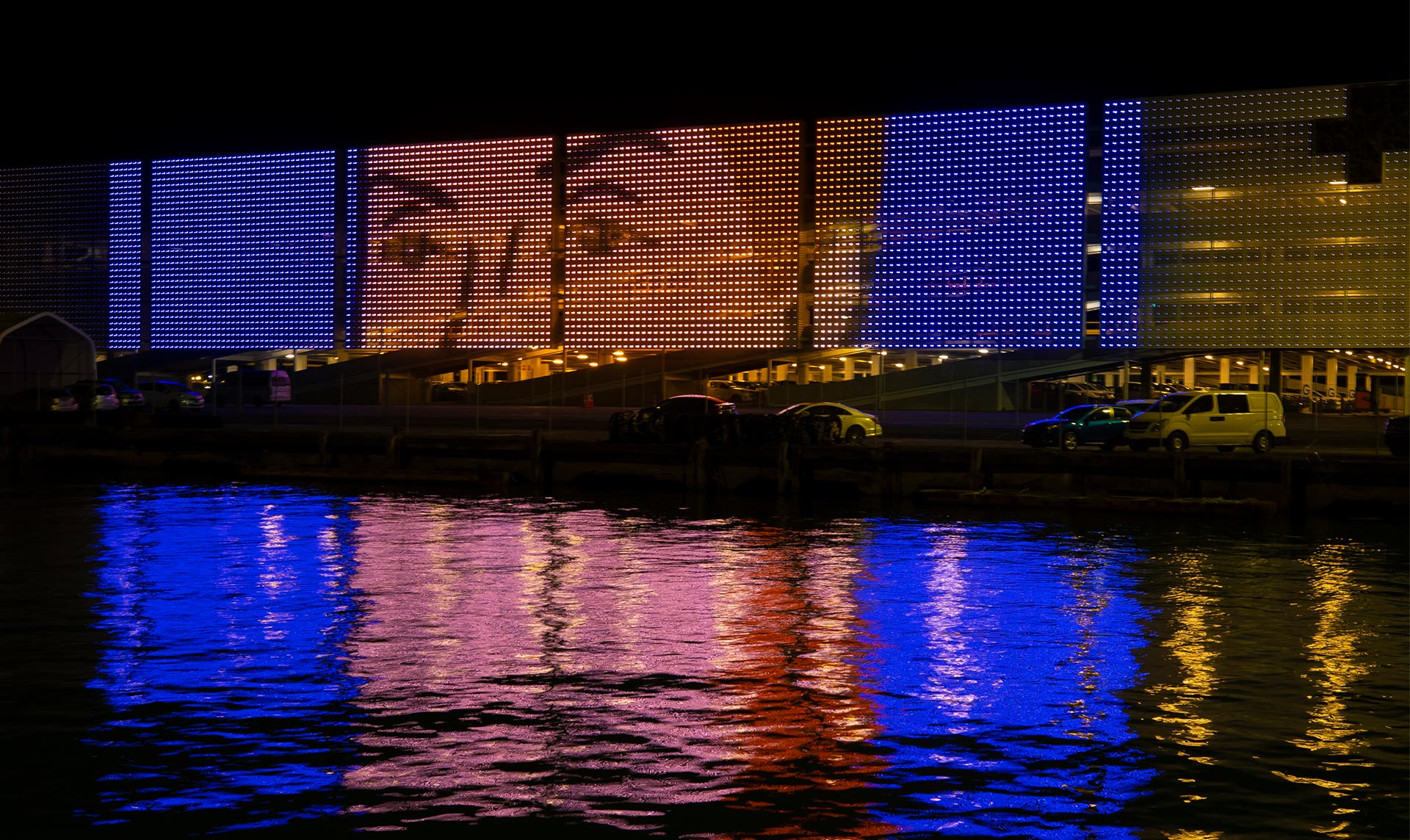

Cinema was Monū’s teacher. They are “made up of movies”. Narratives and images from elsewhere spoke to feelings and experiences not reflected in Monū’s immediate environment. Spanish melodrama and Japanese animation gave permission to the queer part of the artist’s identity. Now, as the artist actively reimagines characters from global cinema as Tongan, they seek a Pacific cinematic language; to view and make movies that reflect the wide, vastly different, personal and intricate diasporic experiences of Pacific peoples in a global society.
Sione Tuívailala Monū is an artist of the Tongan diaspora. They live between Canberra Australia and Auckland, and works across the mediums of photography, moving-image, fashion and adornment, performance and drawing exploring identity, family and pasifika queer experience in the diaspora.
Recent exhibitions include: Spheres: An Online Video Project, 2020; Christchurch Art Gallery, Kahoa Kakala, Fresh Gallery Otara and Objectspace, 2017; Statuesque Anarchy, Enjoy Public Art Gallery, Wellington, 2017; Pouliuli, Westspace, Melbourne, 2017; Making Space, Centre of Contemporary Art Toi Moroki, Christchurch, 2017; GG Talk That Talk, Fresh Gallery Ōtara, 2016.
Photography: Brett Phibbs
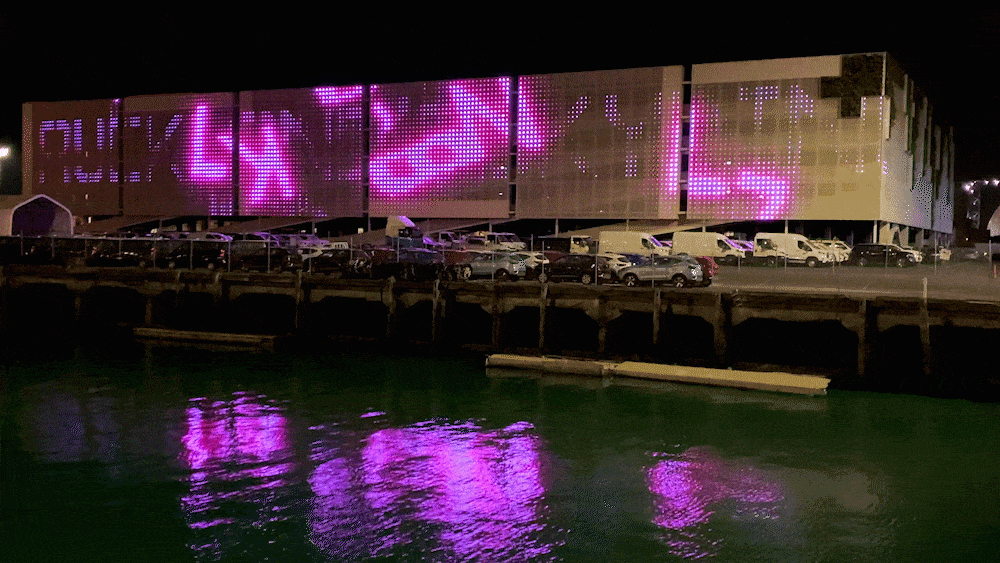


Tyson Campbell presents a lyrical and biographic tale. Set to the poetic and political device of rap music, the city boy biography narrates the complexity of navigating citylife as “white-palatable Māori”. Like a series of thoughts noted-to-phone on the bus ride-home, Skylined memoirs the feelings and tones of living in Tāmaki Makaurau Auckland.
Tyson Campbell (Te Rarawa/ Ngāti Maniapoto) is an Auckland-based multi-disciplinary artist whose work is engaged with the relationships between the indigenous and the settler-state imaginaries. Campbell’s research focuses on Indigenising ways of knowing through relationality and the agency of Whenua.
Tyson is part of the Wominjeka Djeembana Research Lab at Monash University and is also Assistant Curator at Artspace Aotearoa.
Photography: Brett Phibbs
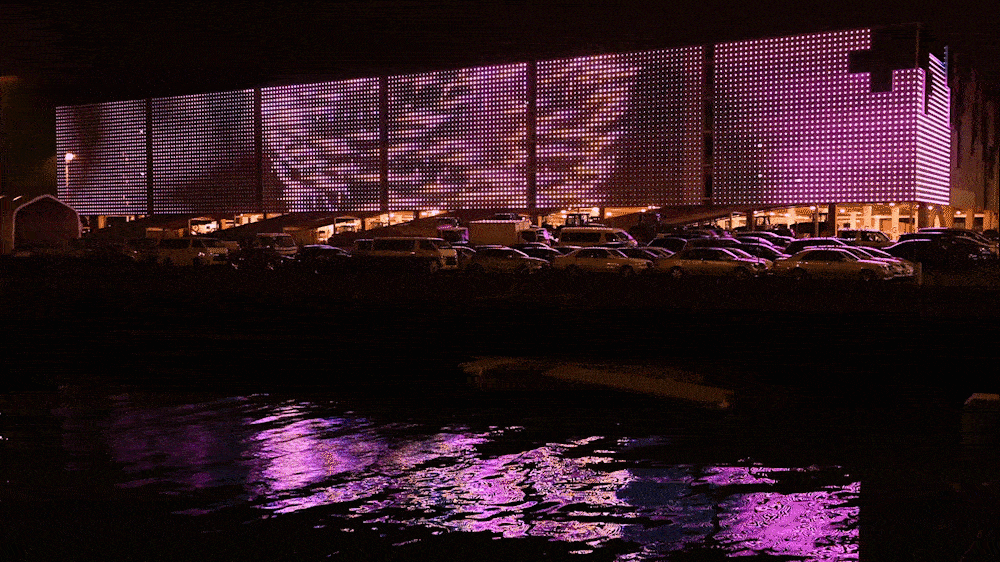
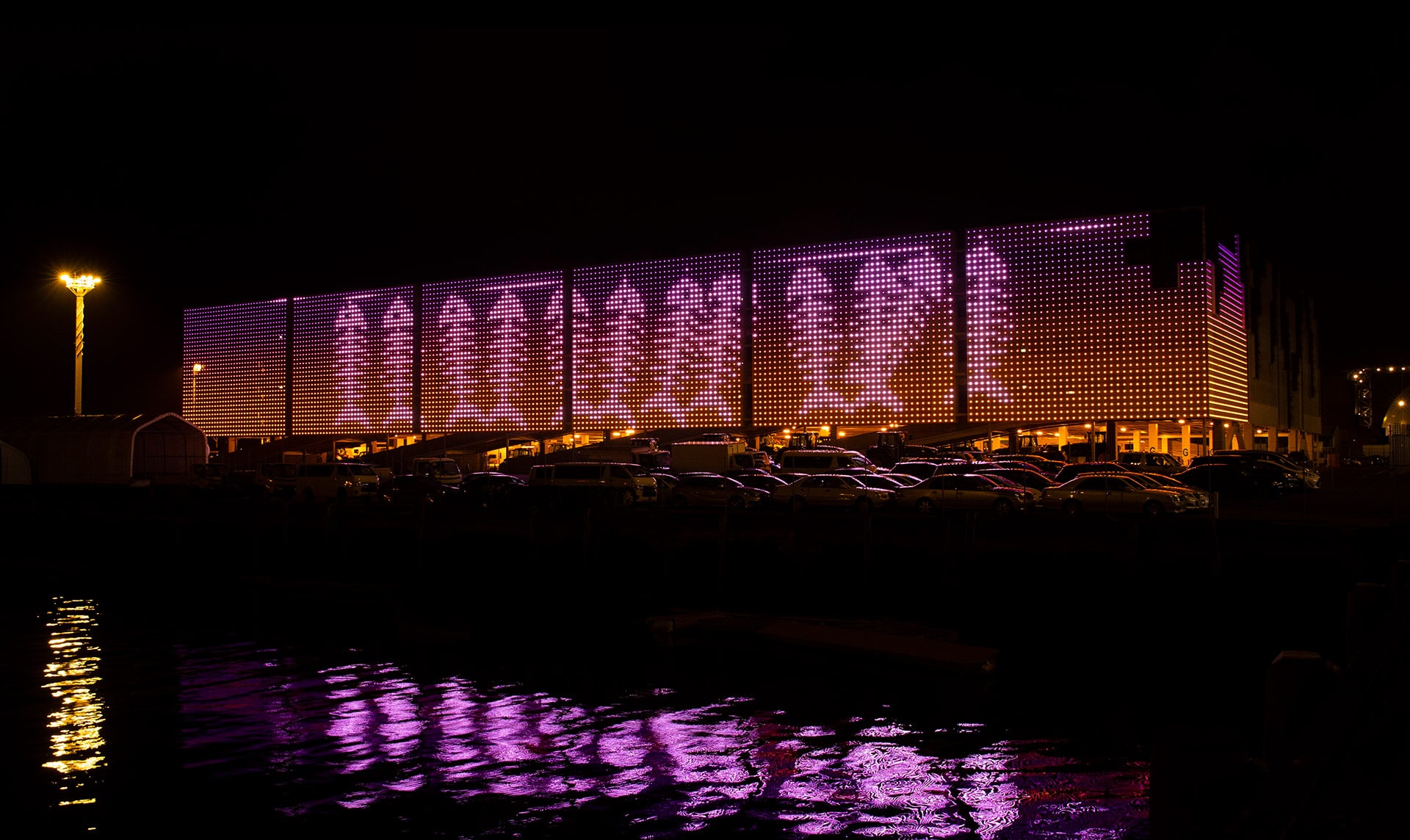

Sorawit Songsataya: “Come up for air studies the ecology of the water and its edge. Reducing these large and intricate habitats to patterns and movement, the artist maps processes of coordination in the harbour’s natural life and the port’s industry. Borrowing synchronicity from these two differing rhythms, Come up for air looks at the idea of sustenance through contrasting scales of mass economic systems and day-to-day gathering of food.”
Sorawit Songsataya’s practice explores the many tangents that connect and redefine our understandings of subjectivity and ecology. Songsataya often employs moving image and sculpture within installation environments, incorporating both digital and tactile media to engage with world-making in imaginative and tangible ways. Recent exhibitions include Rumours (Mermaid), Govett-Brewster Art Gallery (2020) and The Interior, Auckland Art Gallery (2019).
Photography: Brett Phibbs
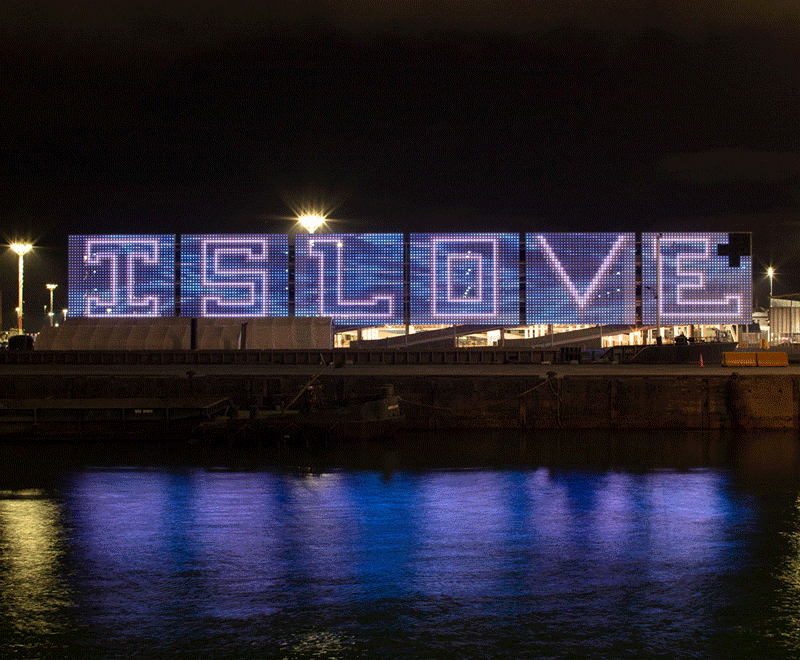
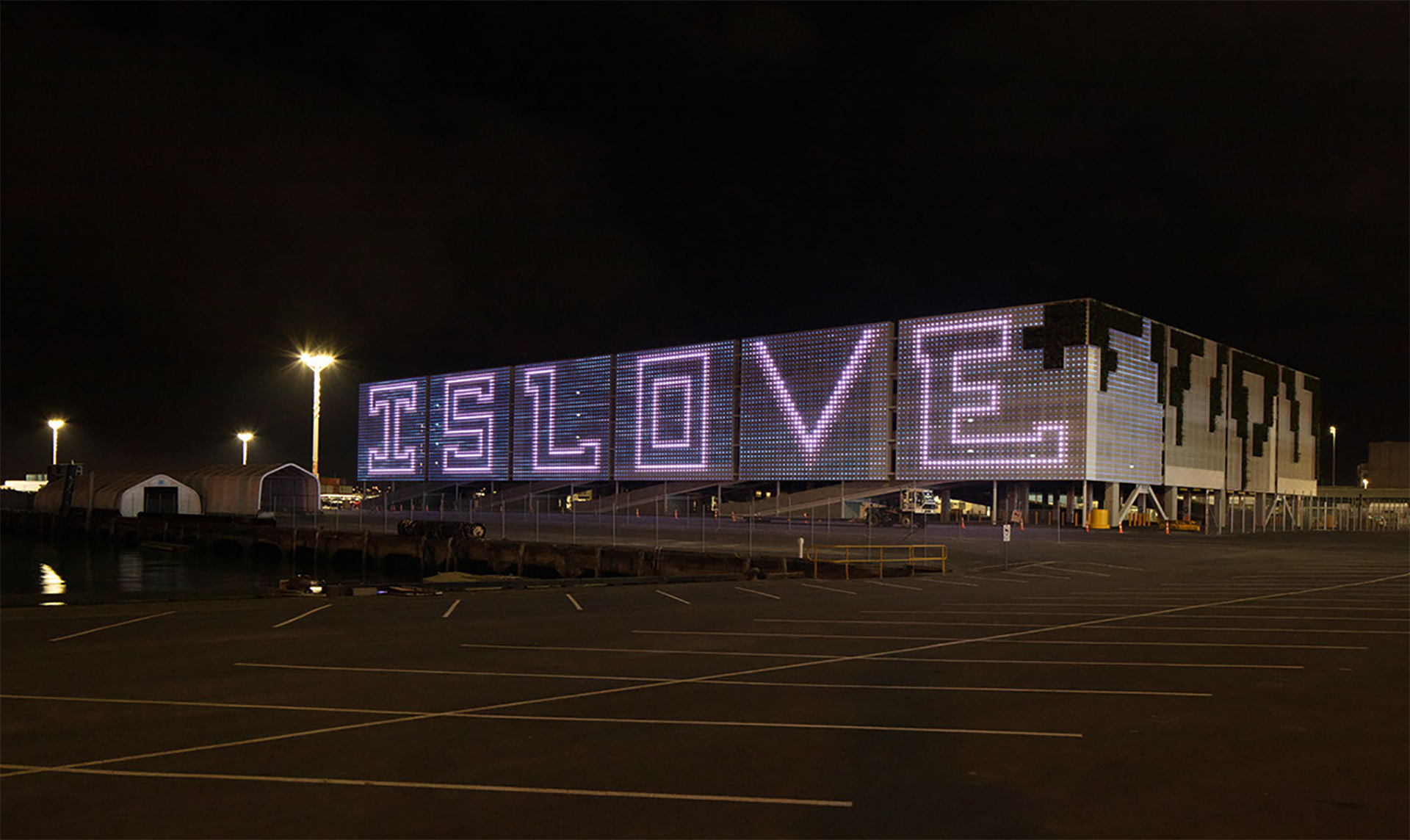

Janet Lilo: “Created for a future defined by the current global pandemic, BLM, social and political upheavals, and great loss, ISLOVE refocuses Auckland’s harbour as a place of connection and light.”
Janet Lilo (b.1982, Te Rarawa, Samoa, Niue) lives and works in Tāmaki Makaurau Auckland. Her work has been exhibited in Asia, Europe, America and Moana Pacific - with extensive shows throughout New Zealand - from Auckland Art Gallery, Te Papa Museum and Christchurch Art Gallery. www.janetlilo.com.
Photography: Simon Devitt
